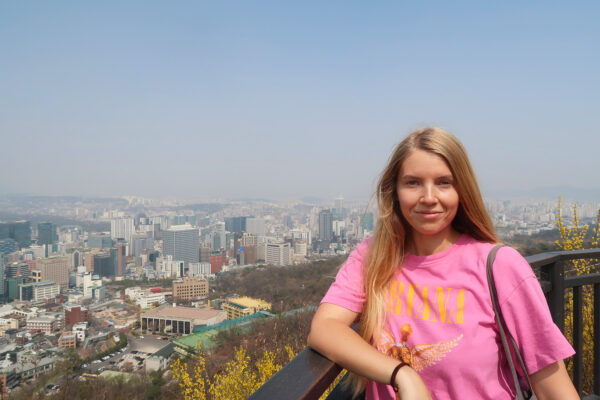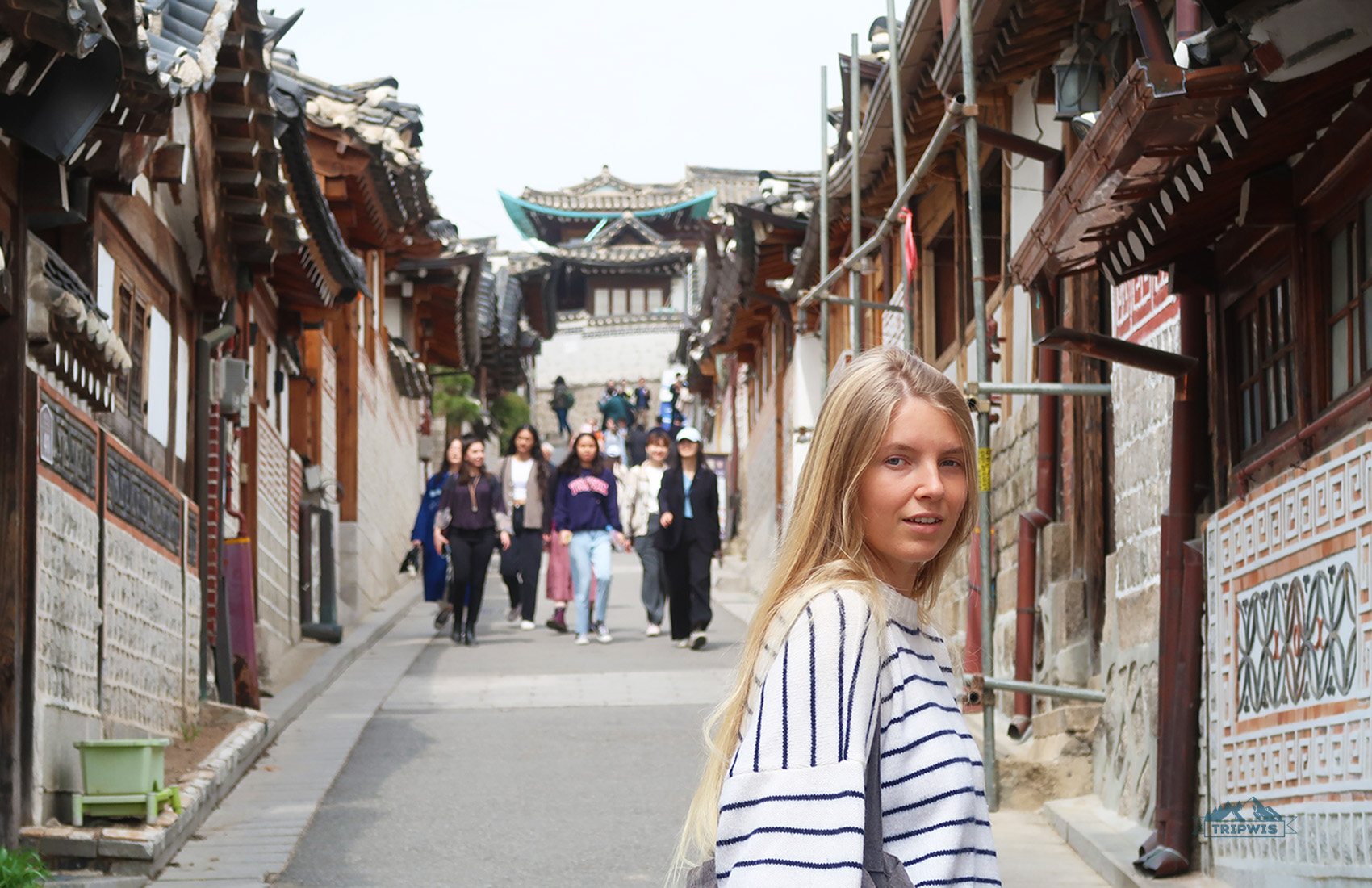
For our first trip to Seoul, I picked a place to stay on a whim — I wanted something cheap and close to a metro station and didn’t bother checking how far it was from the city’s must-see sights (which is how we ended up in Hongdae). For our second time in Seoul, I chose a place with a neighborhood in mind we hadn’t had a chance to explore before (Myeongdong). For the third — and last — trip this year, I figured out that, for us, Seoul has about 6 tourist-friendly districts that are great to stay in.
When you’re not stuffing your face at street food markets or belting your heart out in a karaoke room until 4 a.m., you might find yourself hiking an urban mountain or chilling by the Han River with locals. To make the most of your Seoul adventure, you’ll want to pick the right neighborhood as your home base. I’ve put together a quick breakdown of Seoul’s best districts and what makes each one worth checking out!
Article contents
- Where to stay in Seoul:
1.1. Myeongdong — great for first-time travelers
1.2. Insadong — Seoul’s cultural heart
1.3. Bukchang-dong — Seoul at bargain prices
1.4. Itaewon — nightlife and steep slopes
1.5. Hongdae — Seoul’s youth district
1.6. Seongsu — Seoul’s industrial chic playground
1.7. Gangnam — perfect for shopping - My list of hand-picked Seoul hotels
- My tips for traveling to Seoul
- What is the best area to stay in Seoul?
Where to stay in Seoul: Best neighborhoods and hotels for first-timers
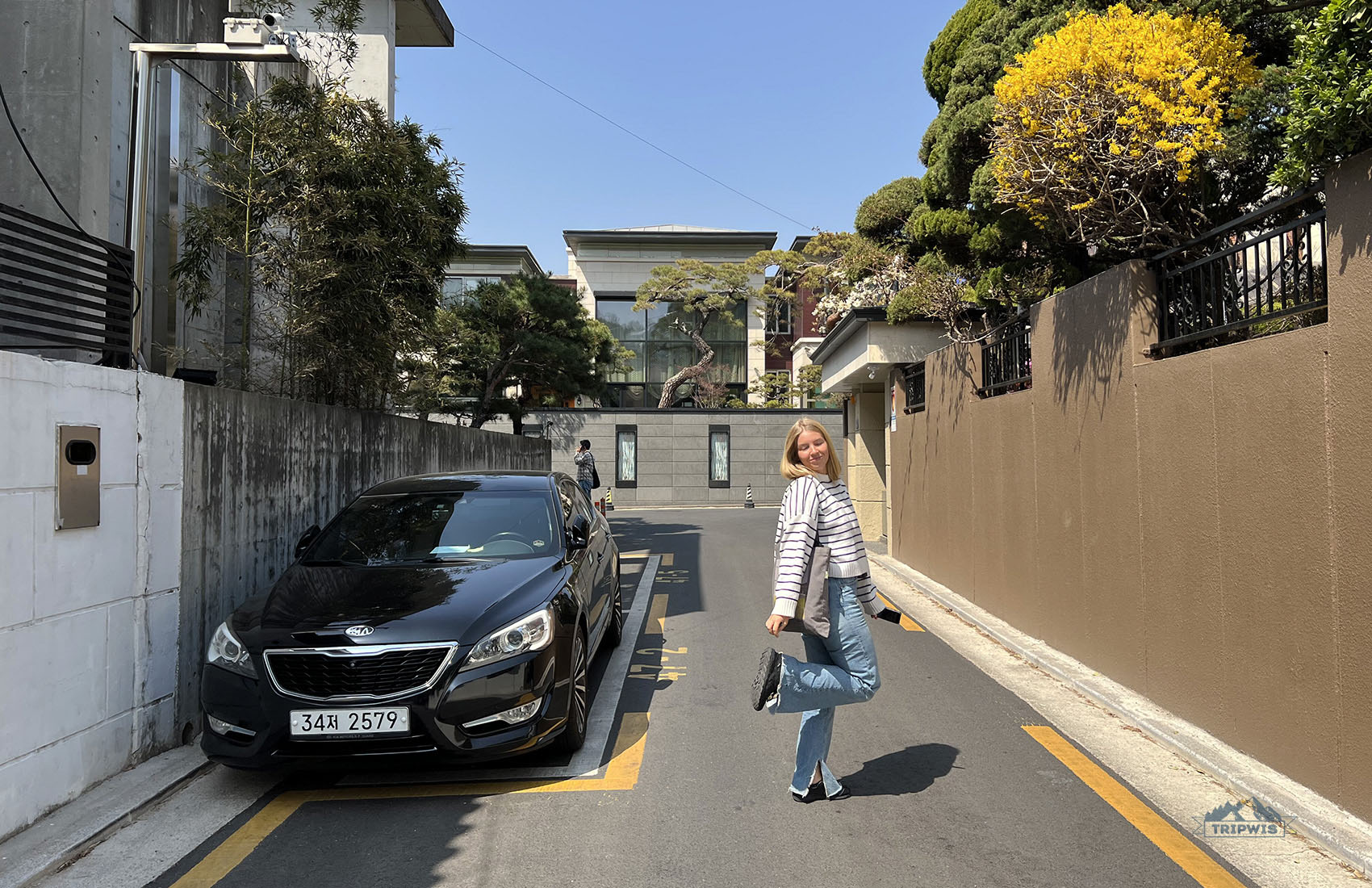
Navigating around Seoul is pretty straightforward — the Han River flows through the city, creating north and south sides.
Most travelers end up spending the bulk of their time exploring the northern half, where centuries-old palaces share neighborhoods with trendy cafés and markets. Across the river to the south, you’ll find the glossy business district of Gangnam (made famous by that earworm of a song) and family attractions like Lotte World amusement park. Choosing where to stay in Seoul is a decision that shapes your entire experience, as every neighborhood here offers its own slice of Korean culture, convenience, and charm.
Pro tip: For your own comfort, choose a hotel near a metro station. Ideally, pick one along Line 2 (the green line), as it’s the “circle line” connecting to the airport and looping around most major attractions you can reach via the metro.
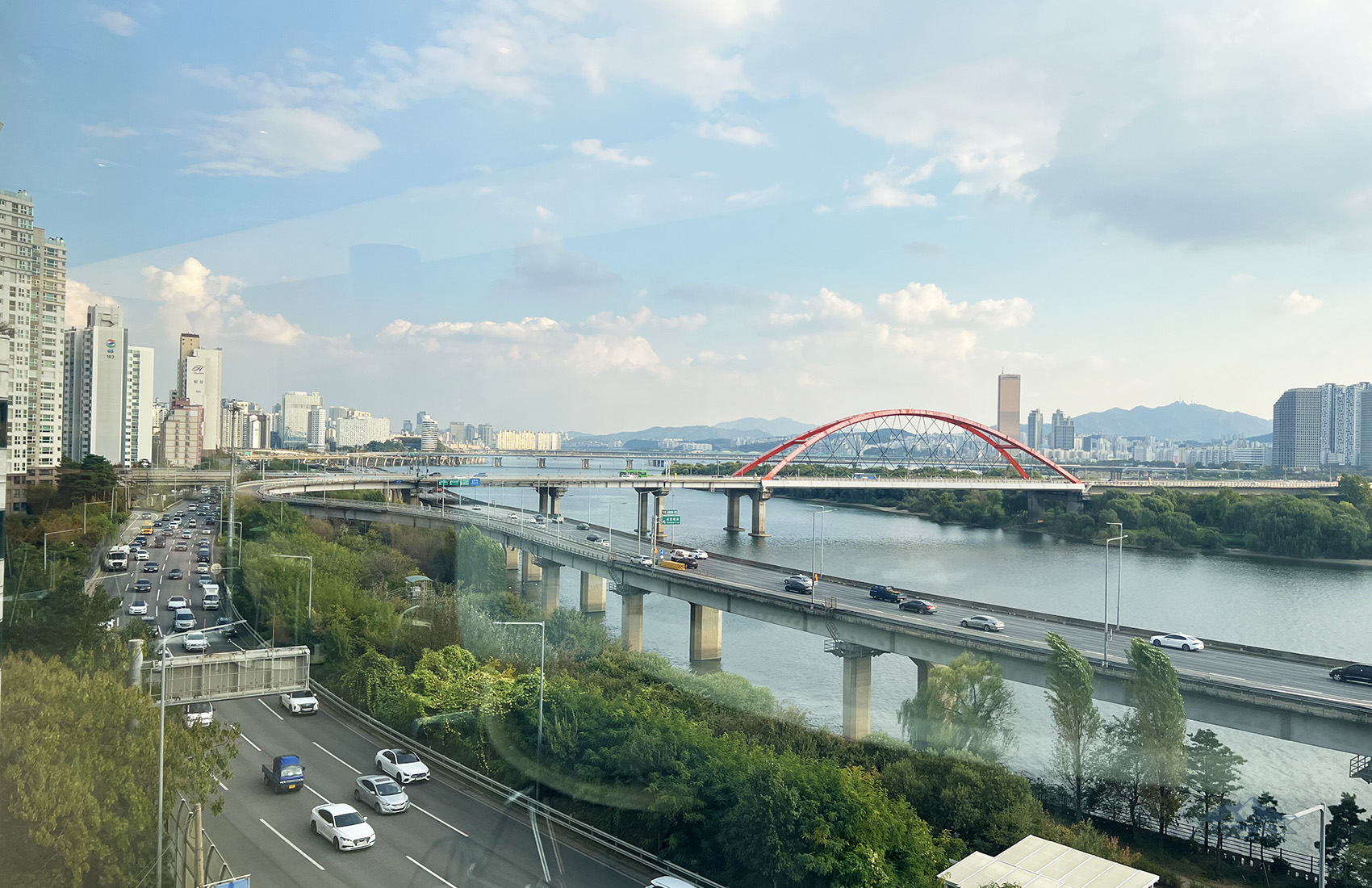
So far, we’ve been to Seoul three times, so we’ve had the chance to try out different neighborhoods:
- Our first visit, we booked an Airbnb in Hongdae and loved the area in its entirety, with its cool park built on former railway tracks (Gyeongui Line Forest Park), countless cafes, shopping centers, and markets. The neighborhood has a great mix of lively streets and quiet corners, but the Airbnb we stayed in was disappointing — a tiny, overpriced studio.
- For the second trip, we switched things up and booked a room at 3* Drip&Drop in Myeongdong — this is a cool hotel-hostel hybrid where you can choose between capsule beds or private rooms, and they hook you up with great FREE filter coffee every morning. Myeongdong itself is basically Seoul’s Times Square — constantly buzzing with crowds, but you literally have everything at your doorstep.
- Our third visit, we stayed close to Myeongdong in again, prioritizing mobility and central location. This time we chose Namsan Hill Hotel: Great value for money plus spacious room and free drip coffee in the lobby.
For our next trip, I’m thinking of venturing further from the center of Seoul. Somewhere like Yeouido-dong to experience daily life as locals do.
Here’s what I’ve learned: Each Seoul neighborhood has its own distinct personality, and the accommodation options are just as varied. Whether you’re hunting for an Airbnb in Seoul, mapping out things to do in Seoul, or trying to figure out which touristic area matches your vibe, you’ve got options ranging from cheaper accommodation to luxury 5-star hotels.
Myeongdong — great for first-time travelers
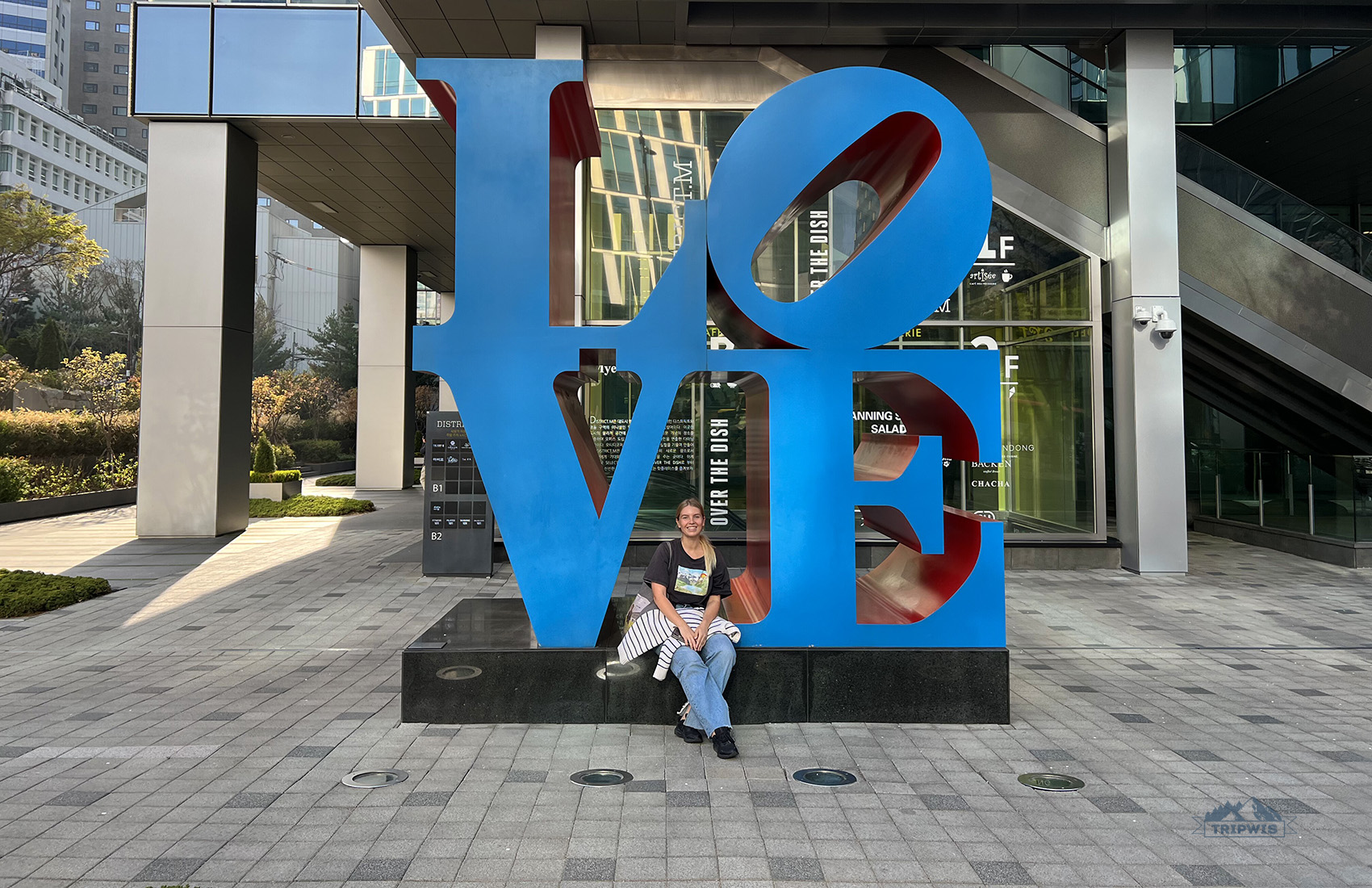
Myeongdong is one of best neighborhoods to stay in Seoul for first-time travelers. Located right in the city center of Seoul with subway connections to pretty much everywhere, this neighborhood lets you dive into exploring Seoul without the hassle of long commutes. When we stayed here, we barely needed public transportation since many attractions were just 30-40 minutes’ walk away.
Myeongdong is your spot if you want to get to know Seoul’s famous shopping scene. There’s even a “landmark” called Myeongdong Shopping Street. The district is packed with everything from luxury brands to street vendors selling those famous Korean face masks you’ve been seeing all over TikTok. And speaking of beauty products — the biggest Olive Young store (Korean version of Sephora) is right here, so if you’re planning to load up on K-beauty goodies, this is the place to do it.
The food here is insane, too. Once the sun sets, Myeongdong transforms into one of the best neighborhoods in Seoul where Korean street food classics blow your mind. You’ll find yourself juggling hot fish cakes, cheese-filled hotteok (Korean sweet pancakes), and impossibly long ice cream cones while trying not to spill on yourself — it’s part of the experience!
For music lovers, there are tons of stores that sell K-pop merch and the latest albums. You might even catch impromptu dance performances by aspiring K-pop stars on the weekends.
When you need a break from the constant buzz (trust me, you will), Namsan Park — Seoul’s scenic mountain park — and N Seoul Tower — the 236-meter-tall tower with panoramic observation decks — are just a short walk away. Hike up for some serious cardio or take the cable car if you’re feeling lazy. Either way, once you reach the top, the city noise completely disappears, and you’re rewarded with killer sunset views that make for perfect date nights or Instagram-worthy moments.
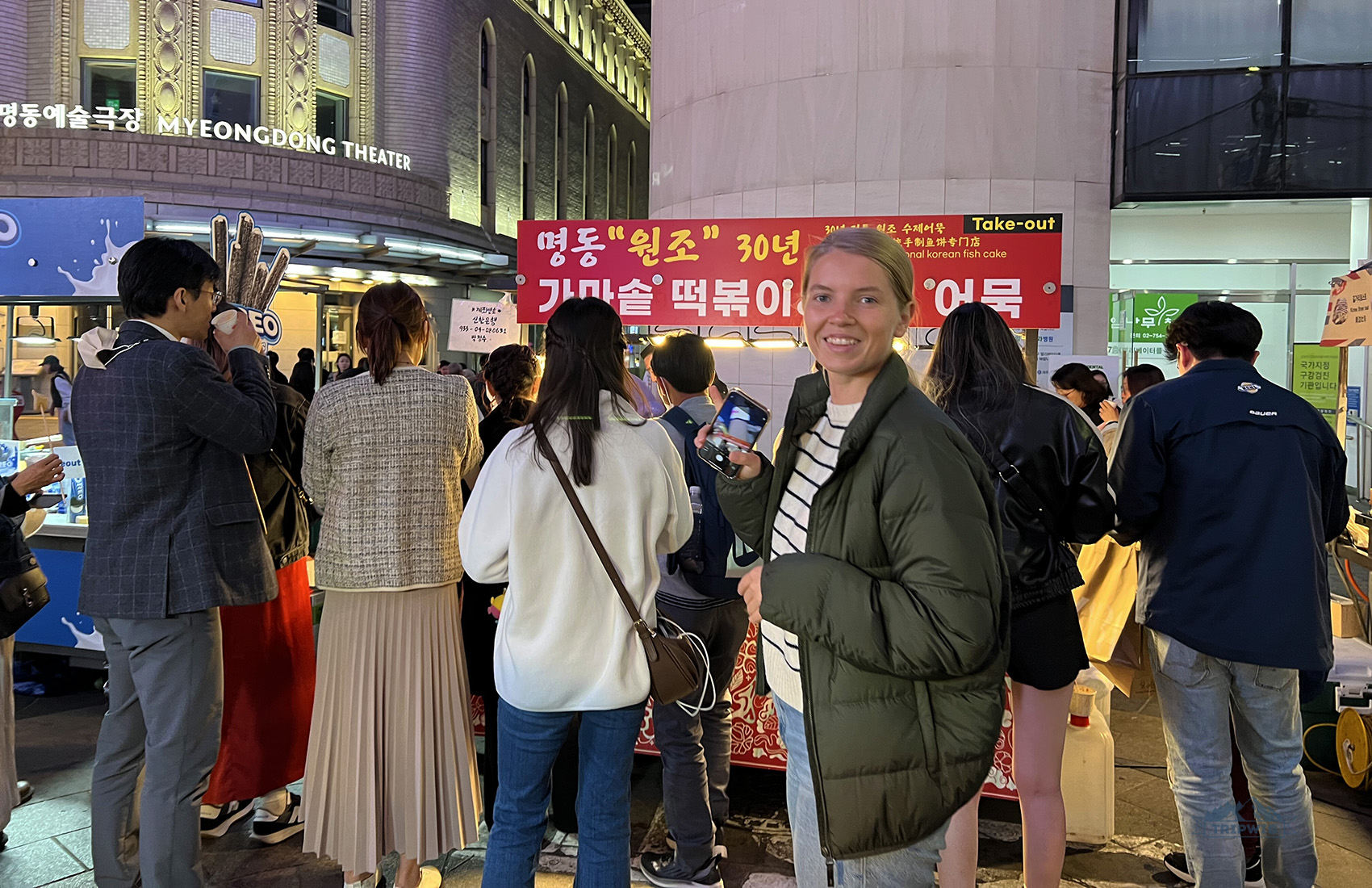
Where to eat in Myeongdong:
- Myeongdong Kyoja — a legendary spot since 1966, famous for its handmade knife-cut noodles (kalguksu), the same but spicy noodles, and dumplings (mandu). Just three items on the menu earned it a place in the Michelin Guide!
- Furoa — a trendy café by day and a bar by night with retro vibes, DJ booths, and a great brunch menu.
- Street food — the neighborhood’s streets can only be described as satisfying chaos of locals and tourists mingling over steaming street food. Don’t miss egg bread and hotteok (sweet pancakes) from Myeongdong’s stalls.
Where to stay in Myeongdong:
- Our choice: 3* Drip&Drop (from $40 per night per person) — budget-friendly capsule hostel which surprised us with a window in each of them. A nice touch considering the capsule concept! And “drip” stands for excellent free drip coffee served daily.
- 4* Koreana Hotel (from $90 per night) — a mid-range stay in a high-rise hotel with spacious rooms (a luxury of living in 28 square meters!) and a decent gym. The location is superb: Smack in the middle of the walking route between Myeongdong and royal palaces.
- 5* Lotte Hotel Seoul (from $260 a night) — iconic 5-star hotel with “upscale” referring to everything: Rooms, dining, spa, golf amenities (!), and direct Lotte Department Store access.
Myeongdong pros:
+ Central location with excellent transport links
+ Shopping paradise (luxury to street markets)
+ Authentic street food and Michelin-listed restaurants
+ Diverse accommodation options
+ K-pop and street culture
+ Home to one of my favorite places for walks in Seoul — Cheonggyecheon park that stretches along the stream and high-rises
Myeongdong cons:
— Can get crowded and overwhelming
— Noise levels in central areas
— Very tourist-oriented atmosphere
Insadong — Seoul’s cultural heart
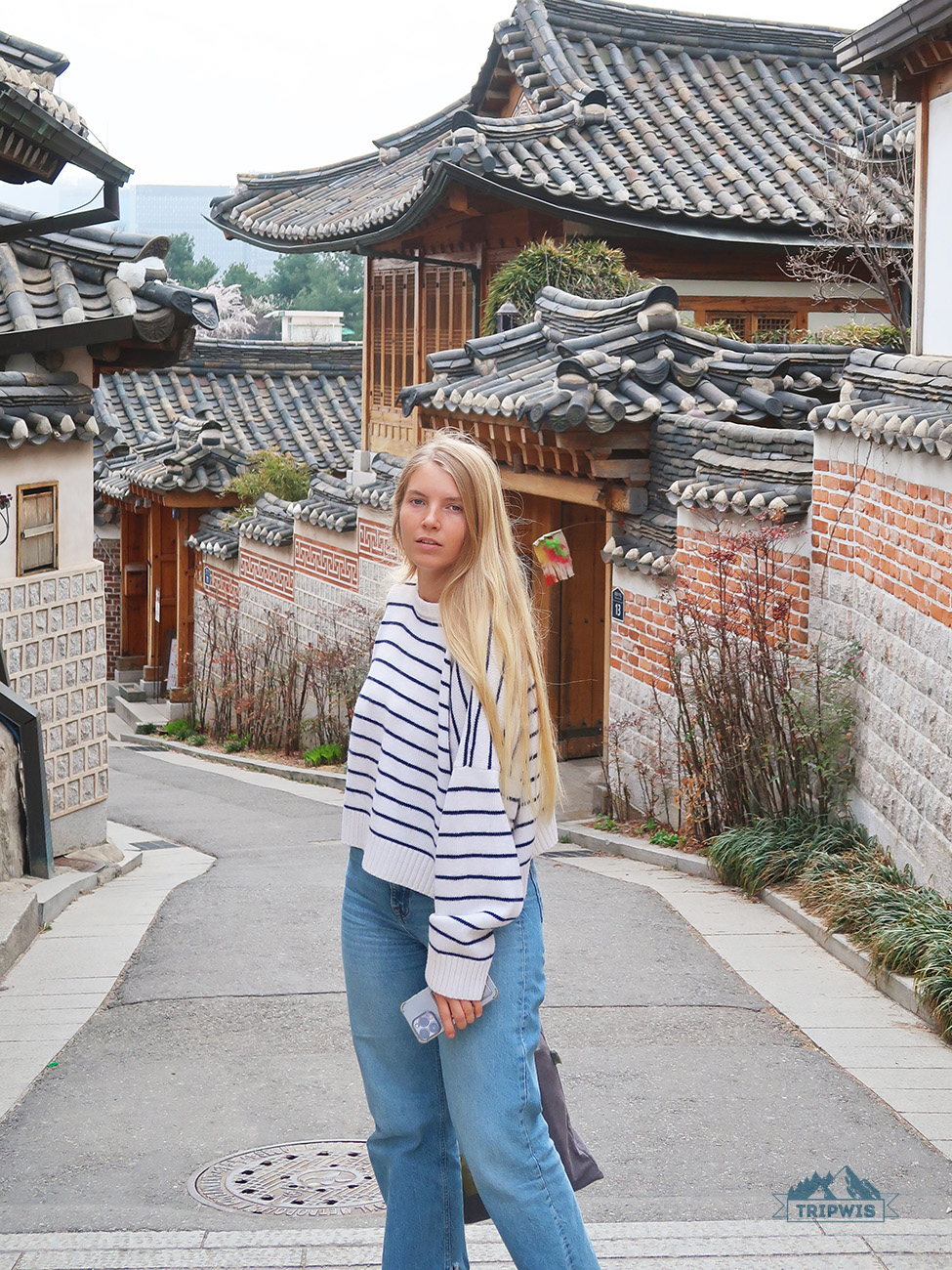 |
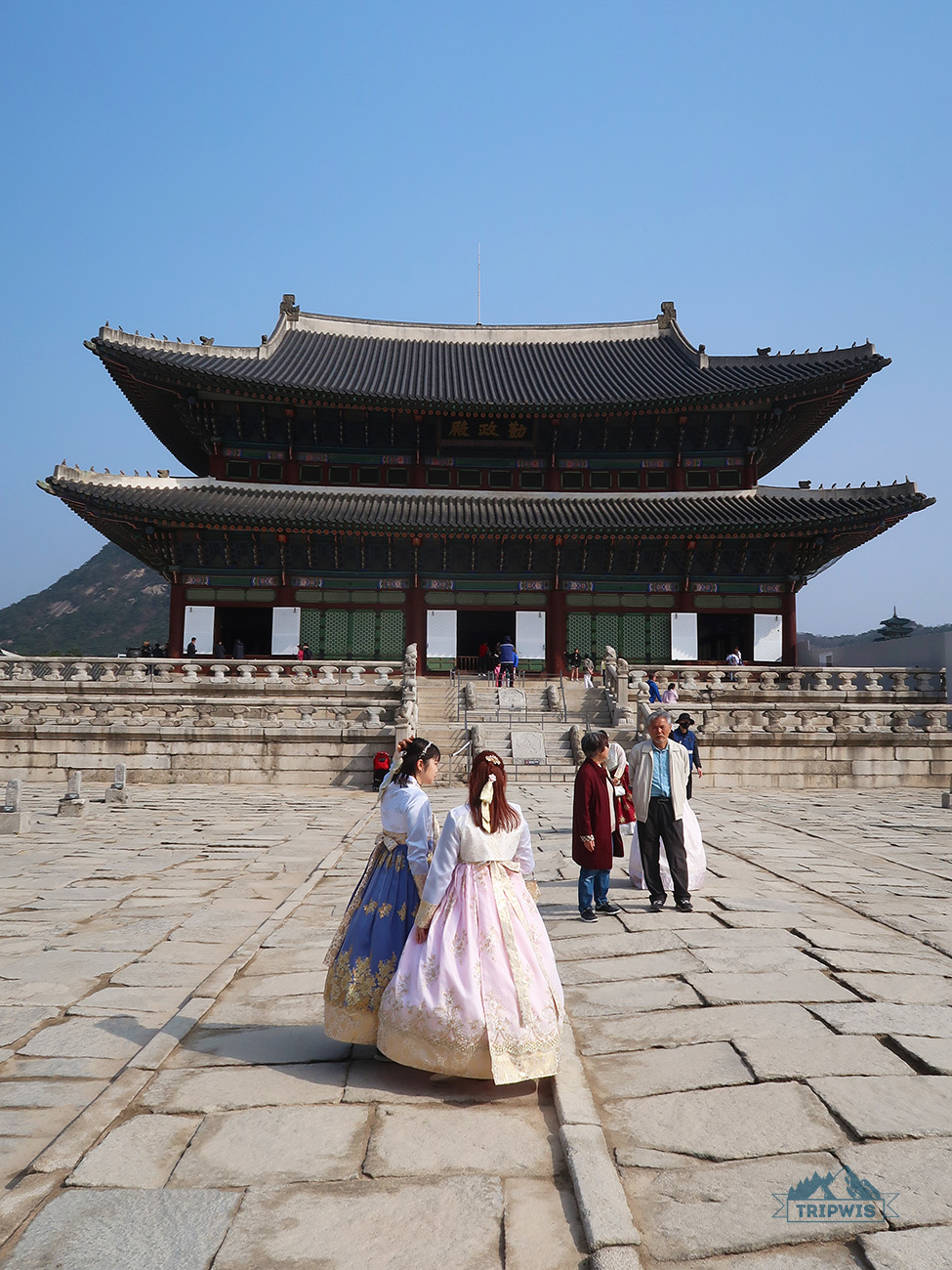 |
Insadong stands out as one of Seoul’s best neighborhoods, as it’s a stylish district brimming with art galleries and craft shops where artisans sell their handmade creations. Walking through these charming streets feels like stepping into Korea’s creative soul — imagine Brooklyn’s Williamsburg, but with a distinctly Korean heritage twist. The narrow alleyways are lined with workshops where you can watch craftspeople at work, creating everything from traditional paper goods to jewelry.
This neighborhood is a treasure trove for souvenir hunters. We visited it on our first day and regretted not buying more, as prices everywhere else in Seoul were significantly higher. At Insadong’s many markets, you’ll find an abundance of Korean-themed items, like elegant hairpins styled after those worn during the Joseon Dynasty, traditional hanbok fabric accessories, and handcrafted ceramics.
Hotels in the area range from $70 per night, which is slightly less expensive than Seoul’s downtown districts while offering more character. Located in central Seoul, Insadong is just a 15-minute walk from Gyeongbokgung and Changdeokgung palaces and Bukchon Hanok Village, making it incredibly accessible.
Insadong is also home to traditional teahouses where you can sample Korean herbal teas, numerous galleries showcasing contemporary Korean art, and Tapgol Park — Seoul’s first modern public park and a location from “Squid Game” season 2 (that’s what I found in reviews, I wouldn’t recognize it without this hint).
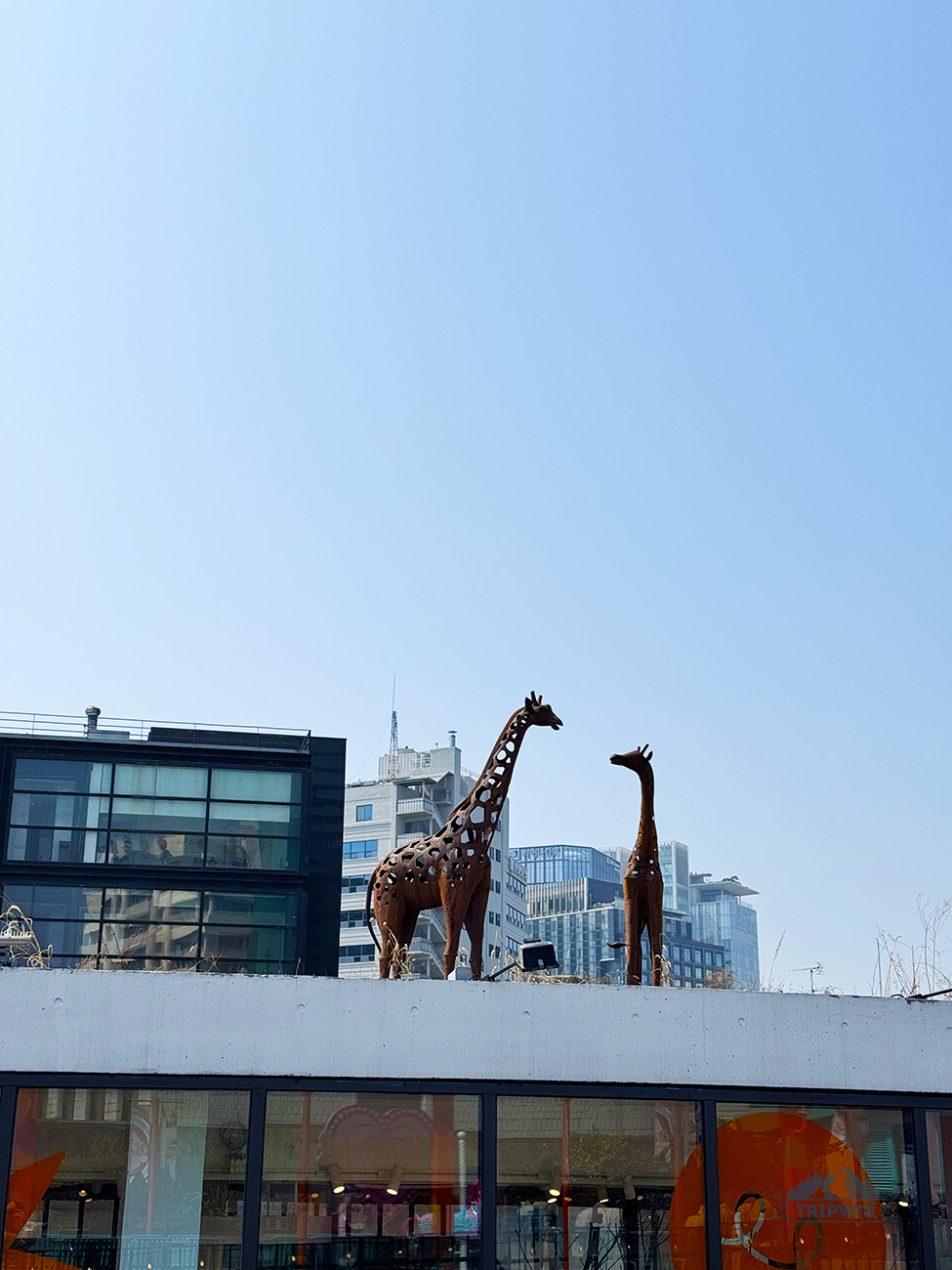 |
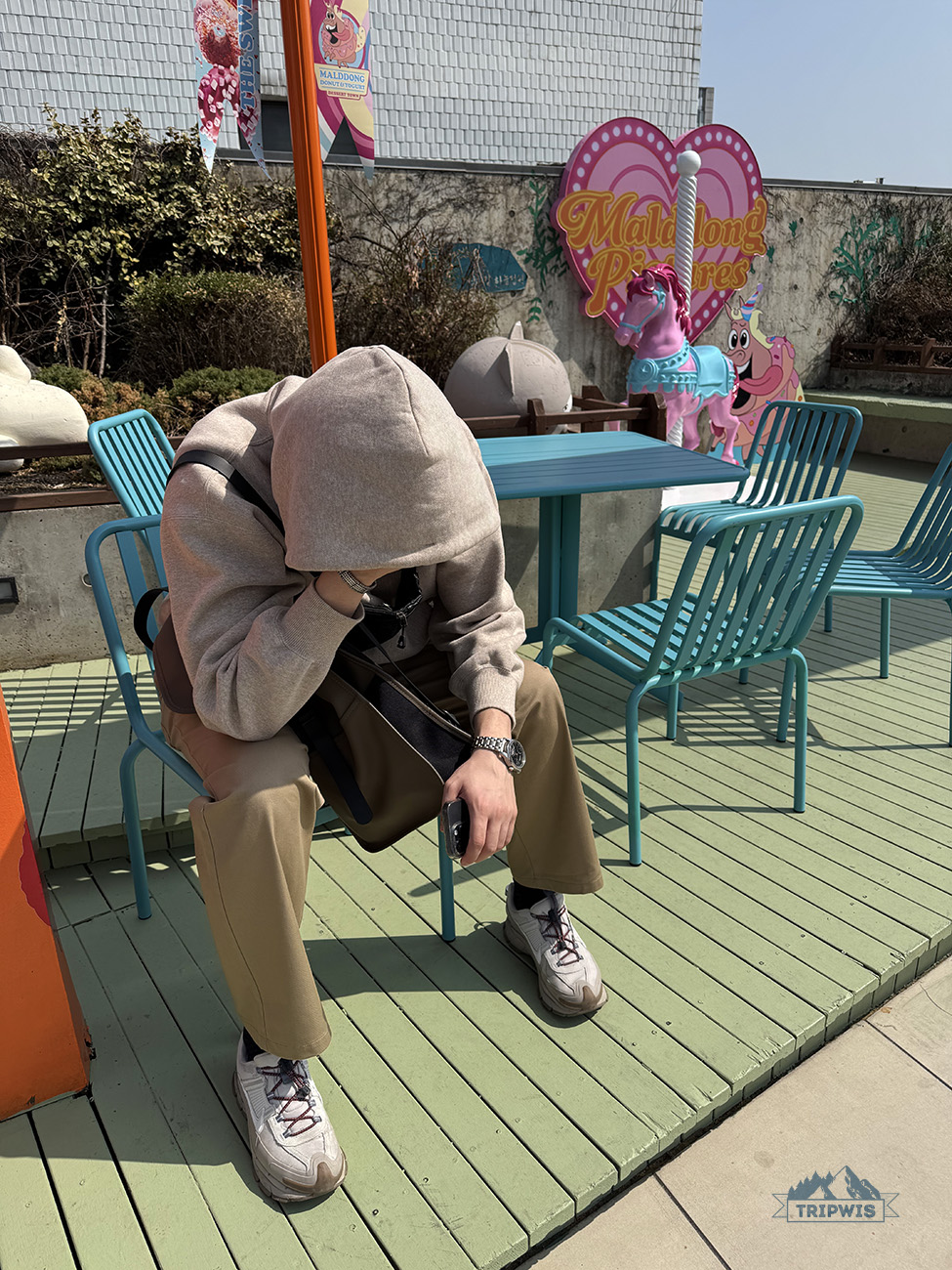 |
Things to do and places to see in Insadong:
- Museum Kimchikan — learn all about Korea’s famous fermented cabbage dish through interactive exhibits and live demonstrations. You can even make your own kimchi to take home! It’s super informative but not overwhelming, with everything explained in English. With Klook’s discount, you can buy the ticket for just $3 — definitely worth it.
- Ssamziegil — hands-down, the coolest shopping spot in Insadong. Instead of a typical mall, it’s built as a spiral path that winds up around an open courtyard. As you walk up, you’ll find tons of quirky shops selling handmade crafts and souvenirs you won’t find at the airport gift shop. The real highlight? The rooftop terrace at the top with awesome views! It’s free to enter and a great place to escape the crowds while still being right in the middle of all the action. And right next to Ssamziegil there is a great vegan restaurant called Osegye Hyang.
- Kyungln Art Gallery Dawon — need a break from sightseeing? Duck into this teahouse, a charming spot in an old-school Korean house. It’s a step back in time once you enter: Wooden tables and floor seating create an authentic atmosphere. Their menu features traditional Korean teas that are both delicious and supposedly good for everything from digestion to stress relief. It’s just around the corner from the shopping spot I mentioned before — the perfect chill place to rest your feet and eyes.
- Woo Lae Oak — the best Korean BBQ that we’ve tried! But we had to earn our way in through the long queues.
- Leah or Komfortabel Anguk — great coffee but not for early birds as they open at 9-10 a.m.
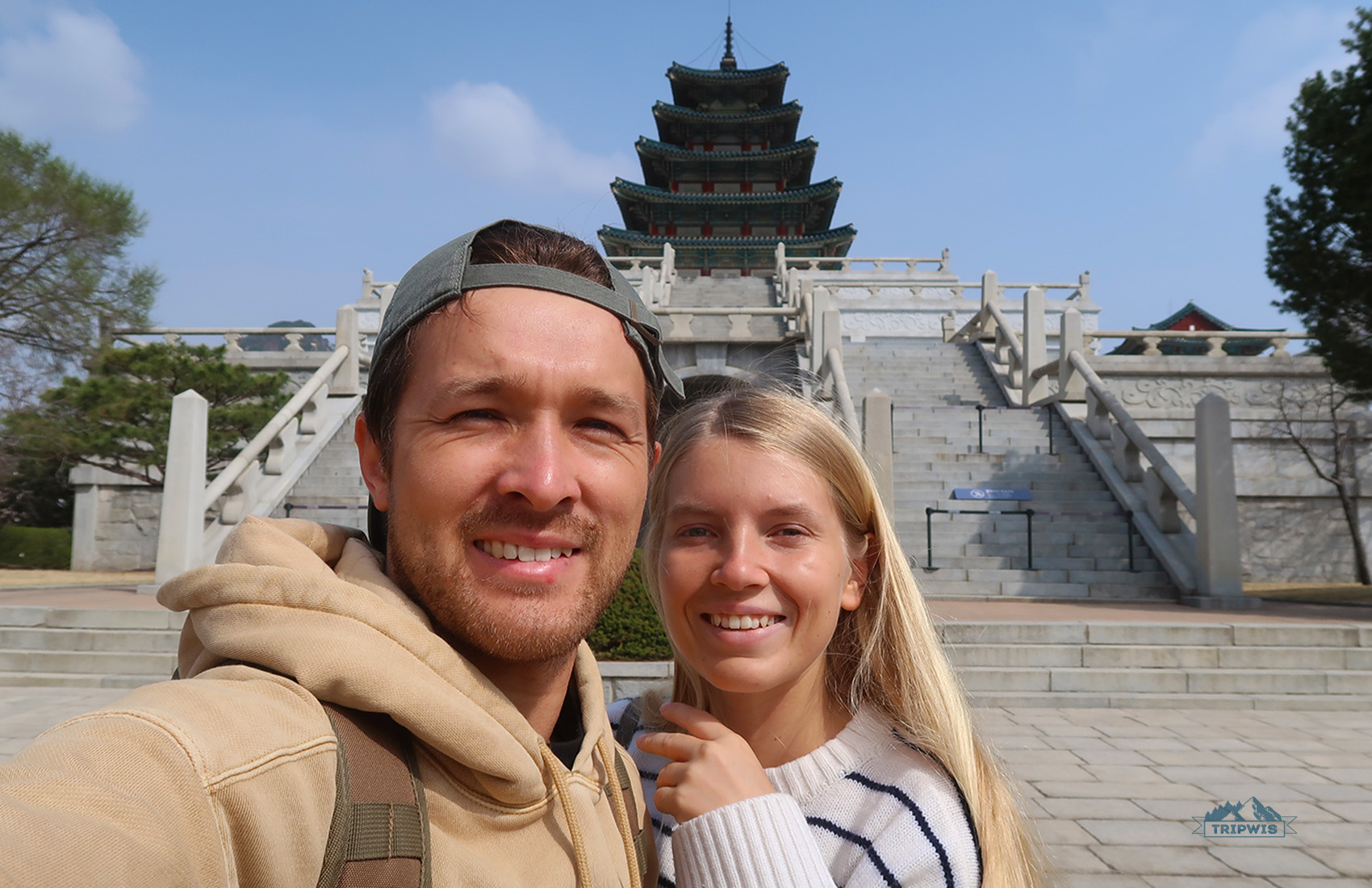
Where to stay in Insadong:
- 3* Dormy Inn EXPRESS SEOUL Insadong (from $100 a night) — a touch of Japanese hospitality right in the heart of Seoul’s cultural hub!
- L Hostel (from $80 a night) — a budget-friendly gem with clean dorms and private rooms, offering free breakfast and a rooftop lounge perfect for meeting fellow travelers.
Insadong pros:
+ Traditional art district with Korean craft workshops and galleries
+ Central location (close to royal palaces and Myeongdong district)
+ Slightly cheaper hotels than downtown Seoul
Insadong cons:
— Limited accommodation options
— Tourist-heavy atmosphere
— Less nightlife than other districts
Bukchang-dong — authentic Seoul at bargain prices
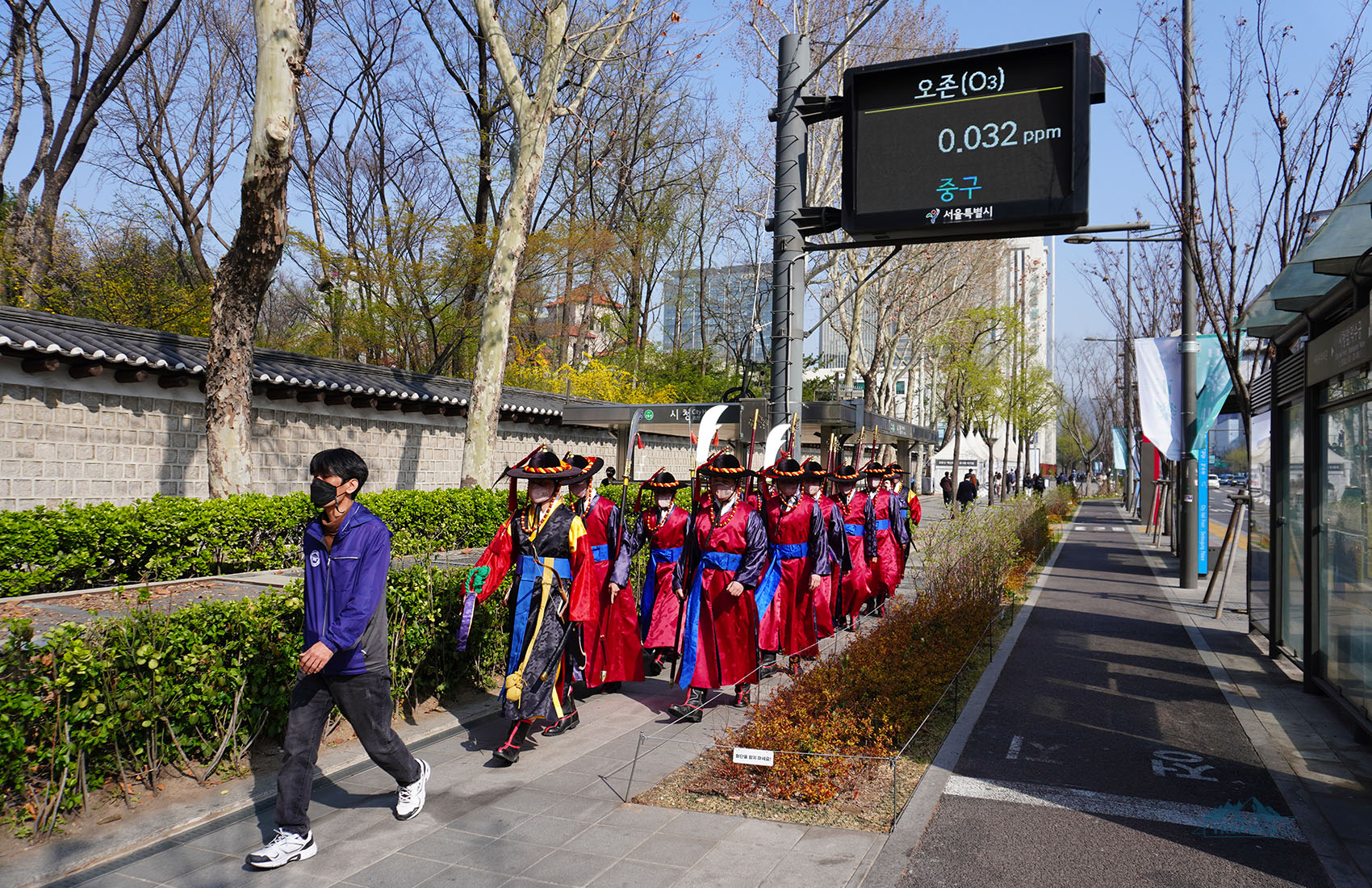
Just a step from central neighborhoods, Bukchang-dong remains one of the city’s parts that most tourists miss. Everyone is glued to Myeongdong or Insadong because, well, they are all over social media, but this neighborhood puts you right where you want to be without the inflated prices of more famous districts!
What really makes this area worth considering is Namdaemun Market — Korea’s oldest and largest traditional marketplace that’s a must-see for a first-time visitor to Seoul. Imagine hundreds of vendors selling literally everything — from socks and tights and used electronics to handmade art and Korean street food. That’s where I got my new camera at Sony store as well as some old vintage buddy for my sister in the alleys of Namdaemun.
All city’s top tourist attractions are either within walking distance or just a few subway stops away. But I would recommend you explore some hidden gems of Bukchang-dong:
- Jeongdong Observatory — a free and not so obvious observation deck on the 13th floor of the office building. A nice spot to look at Deoksugung royal palace, which is right underneath your feet, and catch a glimpse of Gyeongbokgung and the mountains. The viewpoint is open on Mon-Fri (13:30—17:30) and Sat-Sun (9:00—17:30).
- Seoul City Hall — pop into its modern part (open to everyone) to marvel at the multi-story plant garden!
- Seoullo 7017 — a unique city park built on the former overpass; you literally walk between Seoul’s skyscrapers.
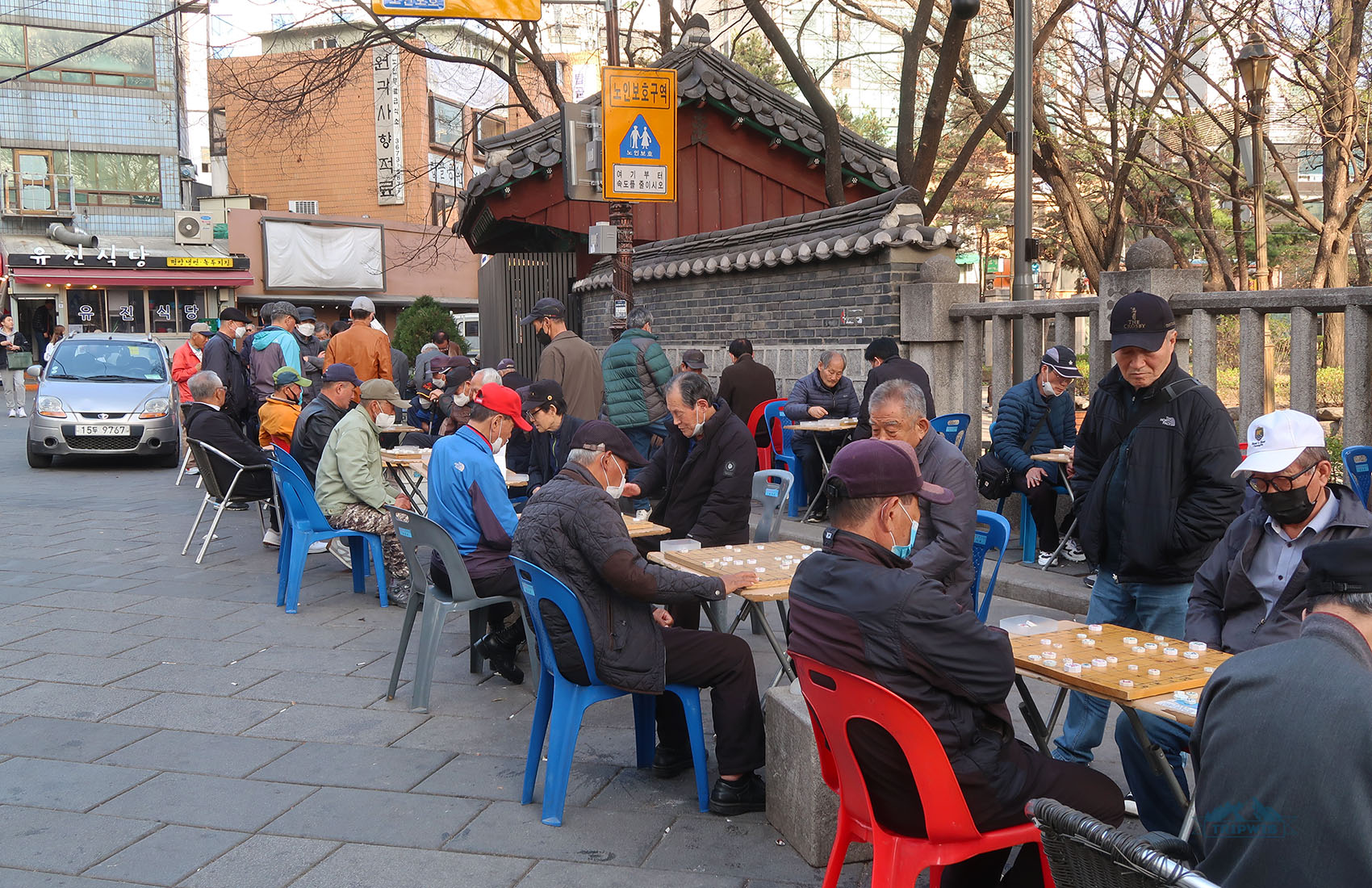
What I like the most about Bukchang-dong, is that it gives you a taste of everyday Seoul — a place where actual Seoulites live and work, not just a tourist bubble. The neighborhood comes alive during lunch hours when office workers flood local restaurants, and again in the evening when small pojangmacha (street food tents) open up. This authentic slice of Seoul life, combined with its strategic location, makes Bukchang-dong an ideal base for travelers who want to experience the real Seoul while still having easy access to all the major attractions.
Where to stay in Bukchang-dong:
- 4* Sotetsu Hotels The Splaisir Seoul Myeongdong (from $100 a night) — an ordinary high-rise business hotel (except for the “Line Friends” theme in the lobby and some rooms) located right in the heart of the neighborhood.
Bukchang-dong pros:
+ Central location
+ Evening pojangmacha (street food tents)
+ Local residential atmosphere
+ Quiet after 9 p.m.
Bukchang-dong cons:
— Limited luxury accommodations
— Restaurants close by 9-10 p.m.
— Limited shopping
Itaewon — nightlife and steep slopes
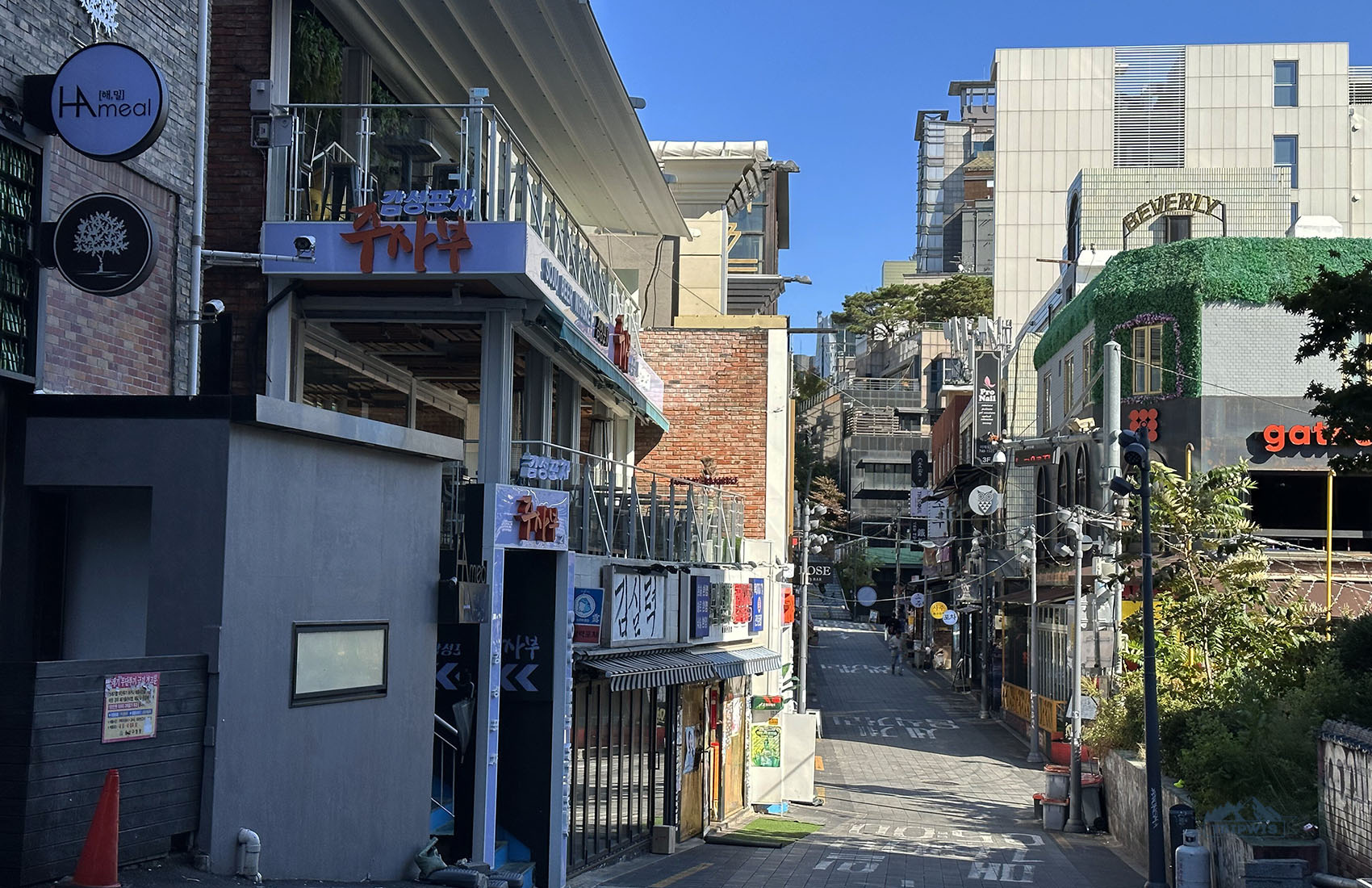
Itaewon stands out as the city’s international hotspot with quite the story behind it. Once dubbed the “American” neighborhood because of the nearby U.S. military base, it’s transformed into Seoul’s cultural melting pot with just enough edge to keep things interesting. When the sun goes down, this is where Seoul comes to play — the main street turns into a buzzing beehive of nightclubs, bars, and restaurants.
Side note: If you’re someone who values a quiet night’s sleep or if you are traveling with toddlers or kids, you might want to steer clear of Itaewon. The neighborhood’s nightlife makes it a challenging place to catch those Z’s.
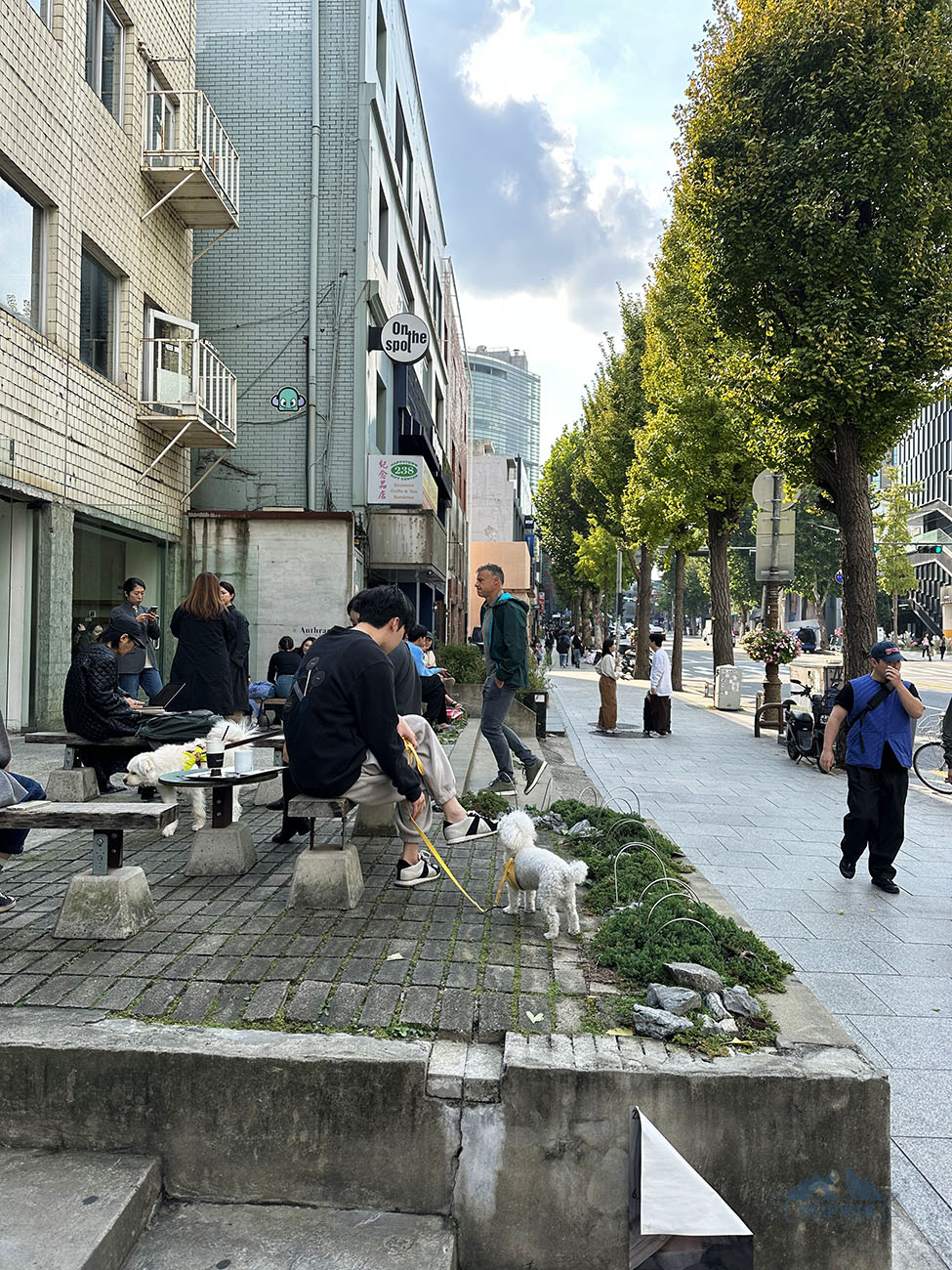 |
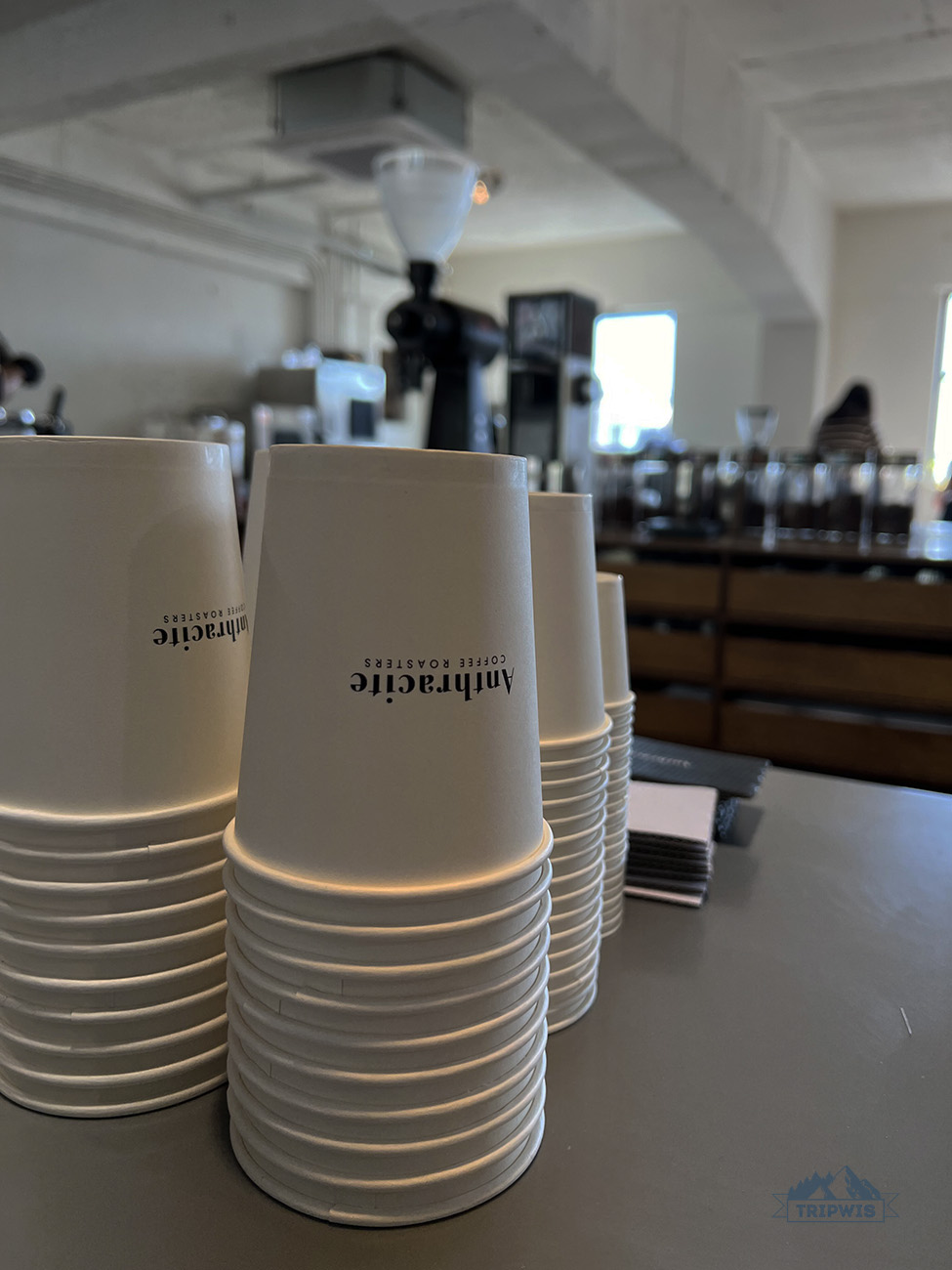 |
What sets Itaewon apart from other Seoul districts is its dramatically hilly terrain. Step away from the main street near Itaewon Station, and you’ll find yourself hiking up and down steep slopes that’ll have your calves screaming. We actually loved wandering these sloping side streets — consider it a free cardio workout during your vacation. The unexpected exercise might leave you breathless, but your fitness tracker will register an impressive step count by day’s end. The neighborhood’s solution to these killer hills comes in the form of adorable mini-buses navigating the steep inclines like determined little beetles. I’m still obsessed with these charming transportation saviors — they’re too cute! The buses are not just practical, but they also add unique character to the neighborhood.
Where to eat in Itaewon:
- Anthracite Coffee — great coffee in an industrial-chic converted warehouse.
- Coreanos Kitchen — the place here bulgogi (Korea’s famous marinated beef dish) meets burrito in the most delicious way possible.
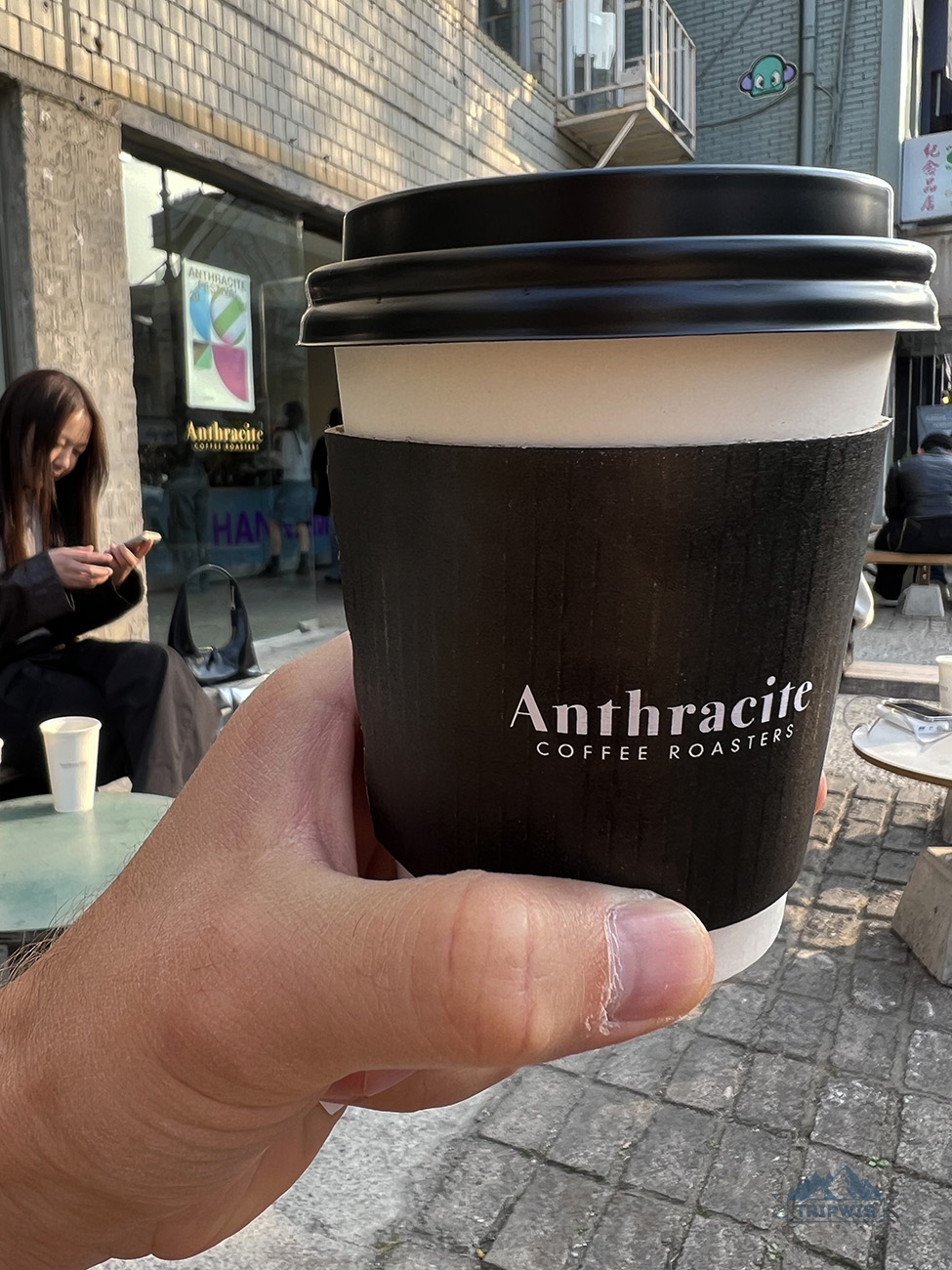 |
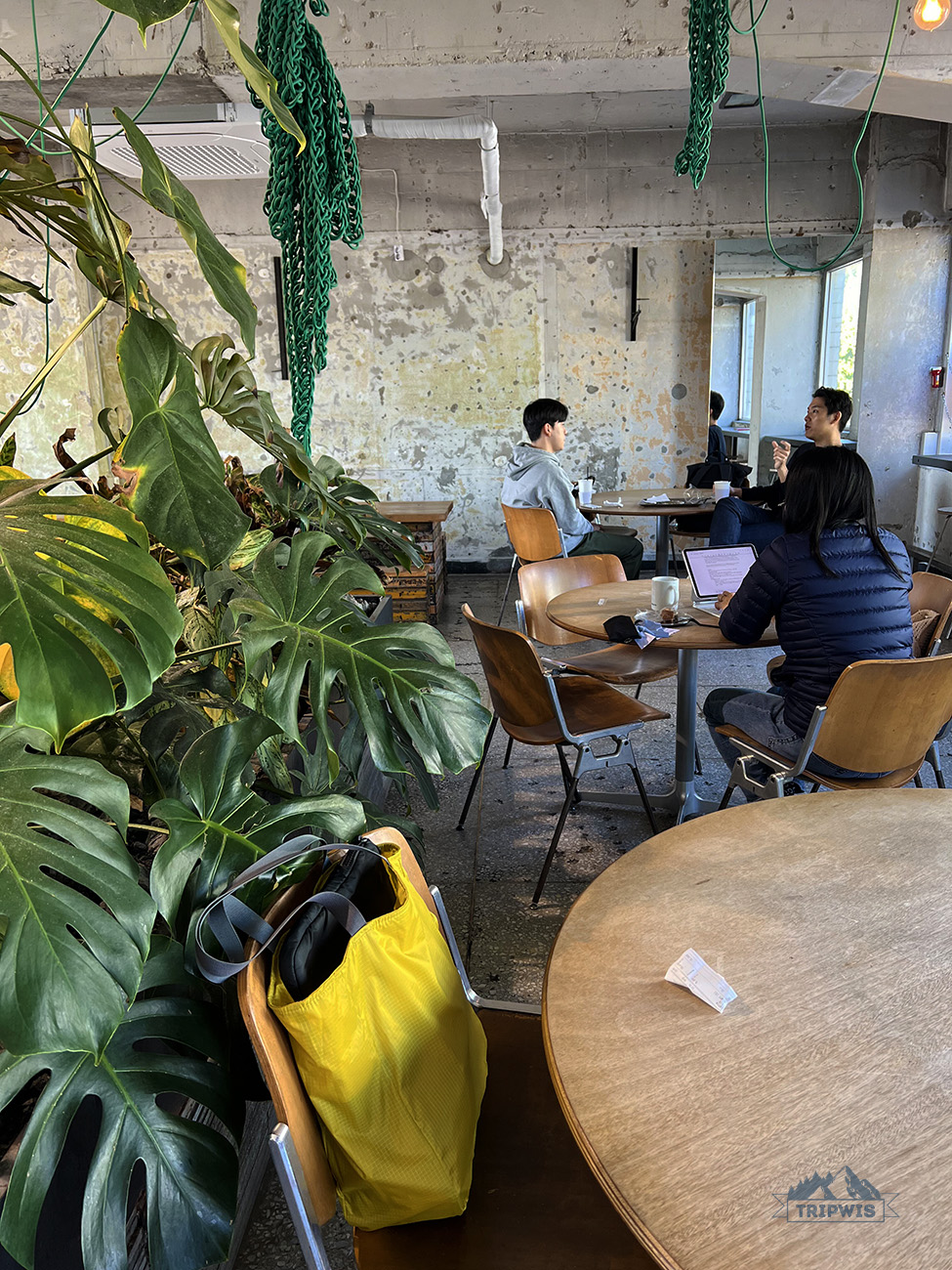 |
Where to stay in Itaewon? Surprisingly, there’s not much hotels here, especially comparing to the central districts:
- 2* H HOSTEL Itaewon (from $50 a night) — a place where backpackers crash in comfy pods, swap stories on the rooftop, and dive right into Seoul’s night life.
- 3* Imperial Palace Boutique Hotel Itaewon (from $85 per night) — one of the few hotels in Itaewon, packed with guesthouses and hostels, offering standard hotel-level service. Not the most impressive option, but for the same price elsewhere you’d likely get less; and here you get 3 stars and a “boutique” label.
Itaewon pros:
+ Nightlife with numerous bars and clubs
+ Diverse expat community and multicultural atmosphere (for example, the central mosque of Seoul is right there)
+ Shopping options from local boutiques to international brands
+ Cheap accomodation
Itaewon cons:
— Can be crowded and noisy, especially at night
— Only three subway stations, located along the main street
— Using subway, you have to transfer to reach the city center
— Less authentic Korean cultural experience
— Tourist-heavy atmosphere in many areas
— Hilly
— Party atmosphere may not suit all travelers
— Less hotels than in other neighborhoods
Hongdae — Seoul’s youth district
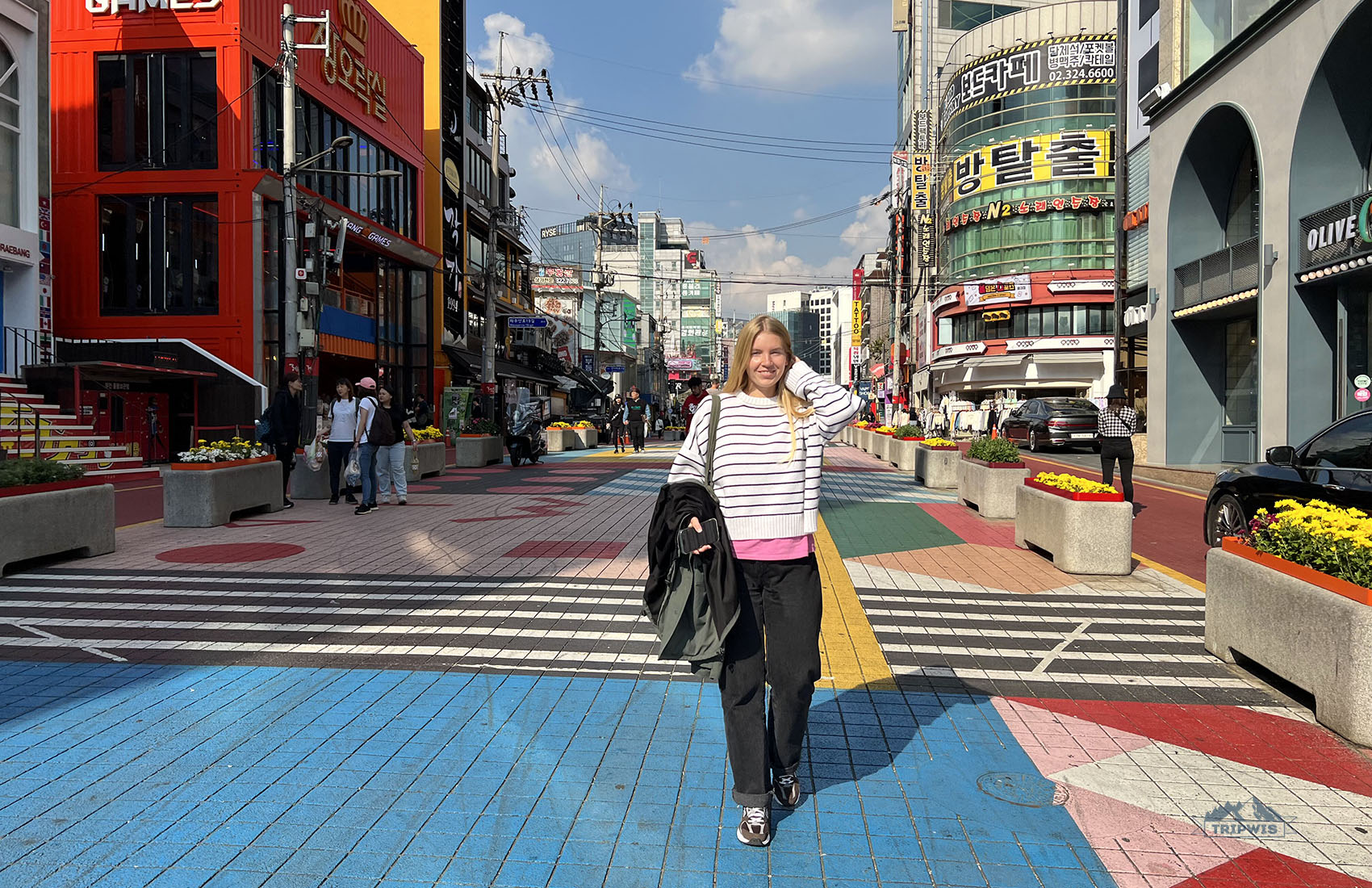
As I mentioned before, the first time we came to Seoul we randomly ended up in Hongdae without giving much thought to the neighborhood. The student vibe hit me right away: I even googled and found several major universities just around the corner.
Hongdae stands as one of the best areas to stay in Seoul if you’re young and full of energy. Or simply looking to spend a bit less on where you sleep. I’d say it strikes the perfect balance between Myeongdong’s endless shopping mayhem and Itaewon’s wild nightlife. Yet, everything in Hongdae feels… more creative. It’s a mix of street art, indie music venues, underground clubs and bars, and modern urban culture.
If you land in the heart of the neighborhood — Hongik University Station — get ready for serious crowds and full-on hustle. To escape the madness, veer off toward the Gyeongui Line Forest Park, a peaceful green stretch built on old train tracks and dotted with quirky cafés and coffeeshops. Or dive into the rhythm of Hongdae and head toward Hongdae Shopping Street to window-shop storefronts and snack your way through endless street food.
Hongdae transportation couldn’t be more convenient, with the area centered near train station Hongik University. It means that all major Seoul attractions are easily accessible by public transport within 15-20 minutes.
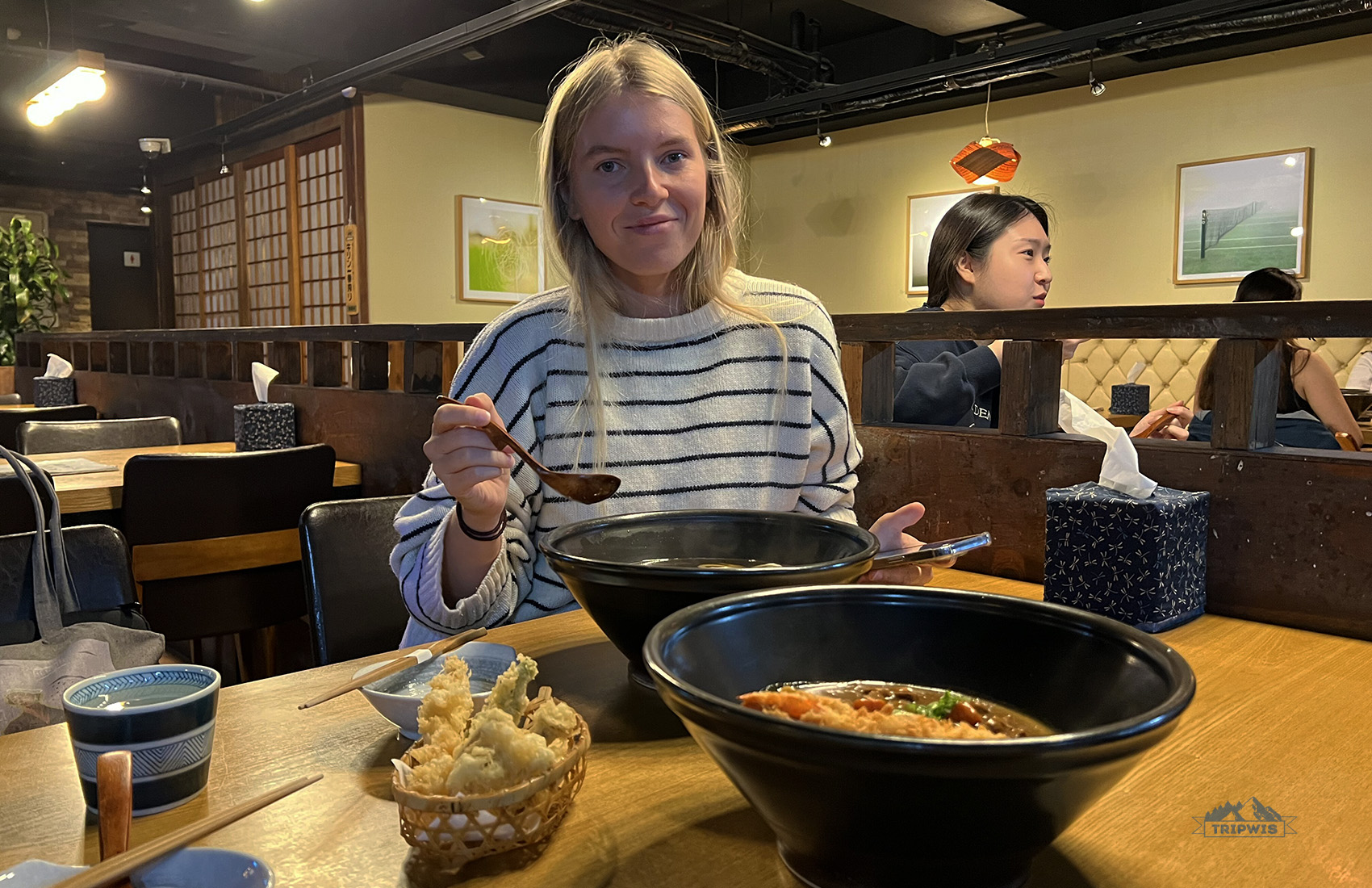
Where to eat in Hongdae:
- Coffee Nap Roasters — this was the coffeeshop that first introduced me to South Korea’s love for bold, unexpected design choices. Here, they built an actual tiled street hill INTO the interior! Excellent flat white goes as a bonus.
- Slow, Cali — Hawaiian poke in case you’re done with South Korean cuisine.
- Oreno Ramen — authentic Japanese ramen and perfect noodles that locals line up for. Ideal comfort food!
Quick tip on one of the best neighborhoods of Seoul where you can save on accommodation: The part of Hongdae above the Forest Park is more residential and chill, while the area below it is where all the action happens.
- DW Stay Hongdae (from $60 a night) — great budget hostel in Seoul; tiny, dorm-like rooms with private bathrooms for a bargain price. If you want an upgrade to an apartment, there is DW Design Residence from the same owners, located very close to the hostel.
- 4* L7 Hongdae by Lotte (from $160 per night) — a full-scale hotel experience with nice rooms, a stunning rooftop infinity pool, artistic touches all around the building, and a big lobby for drinks or working on your laptop.
Hongdae pros:
+ Excellent nightlife
+ Cool cafes, unique boutiques and independent shops
+ Lots of dining options
+ Good transportation links
Hongdae cons:
— Noisy, especially on weekend nights
— Crowded streets and busy public spaces
— Fewer traditional Korean cultural experiences
Seongsu — Seoul’s industrial chic playground
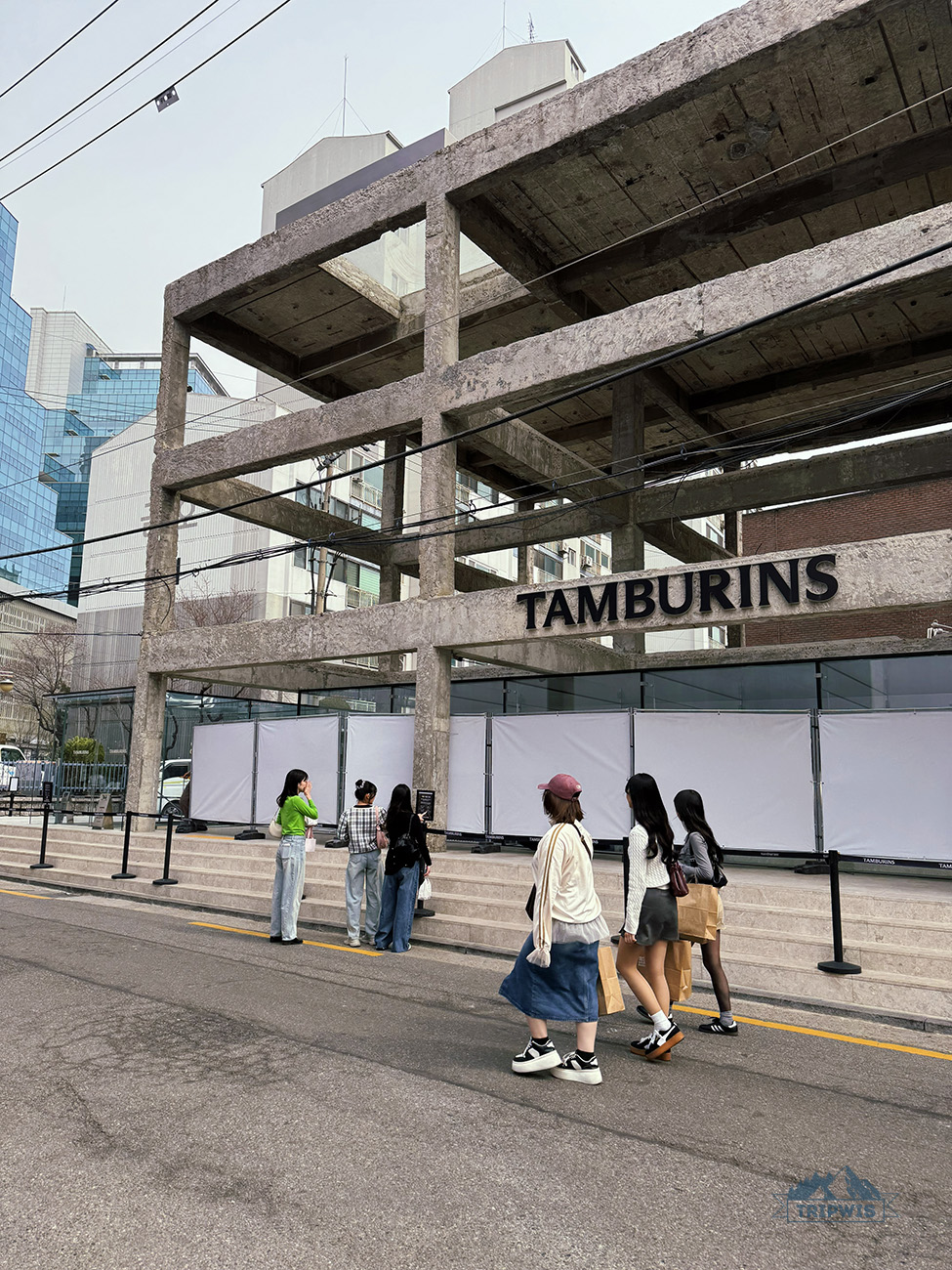 |
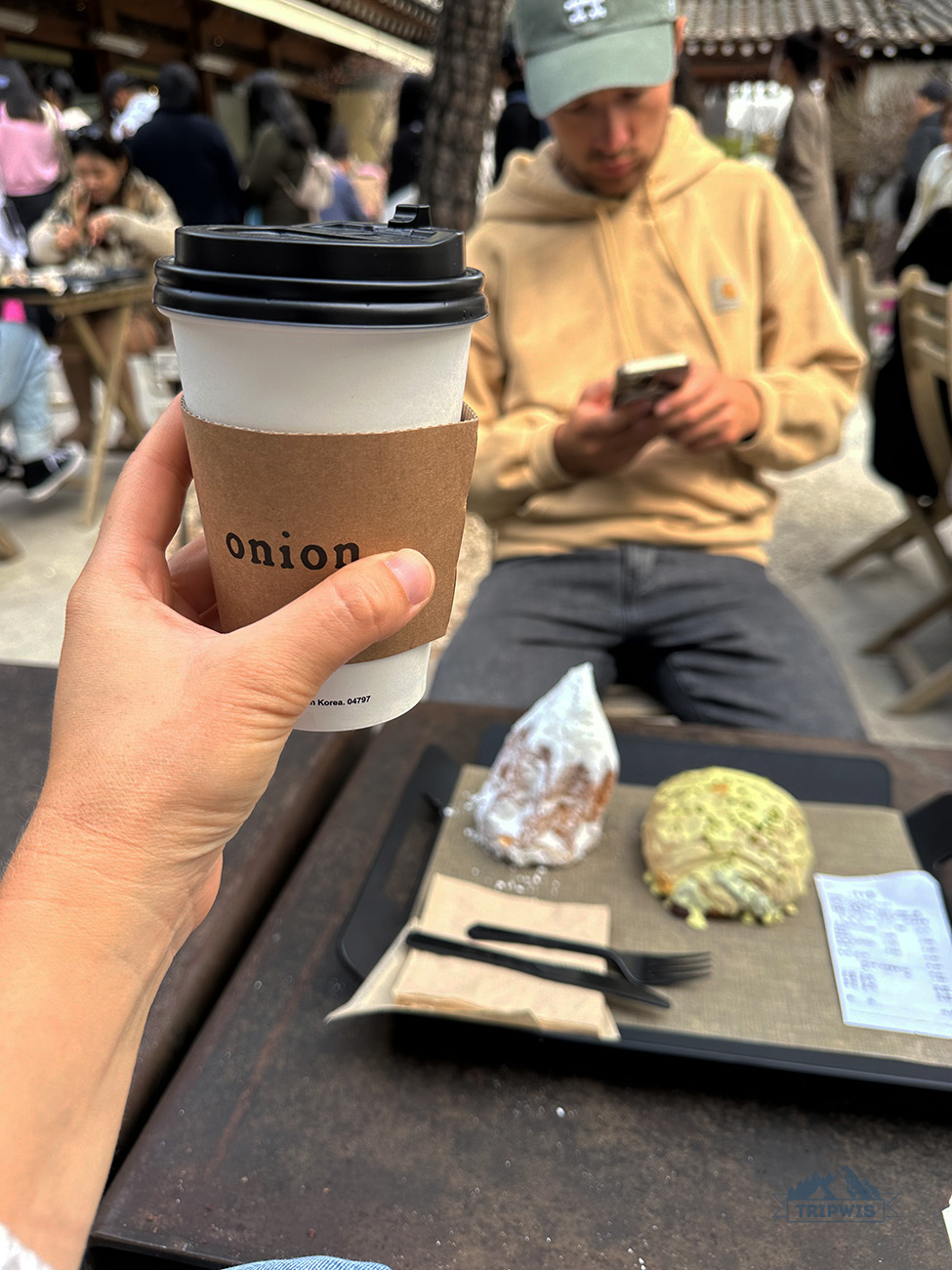 |
Seongsu is Seoul’s poster child for the factory turned fashion district. Rows of old shoe workshops now glow with fairy lights and latte steam, and every corner seems to sprout cute cafes and popups. Because the whole neighborhood leans into a raw concrete, loft style look, even big brands play along: The flagship Tamburins store deliberately left its facade half finished, so buying perfume feels like stepping into an art installation.
There’s no palace or centuries old gate here — Seongsu is about watching an industrial zone flip itself into a design playground, making it one of the best area picks if you’re chasing contemporary art, specialty coffee, and photo ready storefronts.
Yet, getting in and out of the neighborhood might be a pain: Even though Seongsu sits on the circular Line 2, you need to transfer to get anywhere, except Gangnam. But a riverside bike path runs parallel to the tracks if you’d rather pedal than ride, and the airport trains link up with just one easy transfer.
Accommodation-wise, hotels are rare here but you’ll find plenty of Airbnb apartments available for a week or longer, typically a bit below what most central neighborhoods charge, so you can spend more won on extra lattes and late-night street food. All told, Seongsu lets you recharge in a one of the best areas to stay in Seoul that still feels like a local secret.
Things to do and places to see in Seongsu:
- Stroll over to Seoul Forest, a leafy mini park just a few blocks away; it’s perfect for bike rides, admiring art installations, and deer spotting with family before you dive back into the café and concept stores scene.
- Explore D Museum, an industrial space transformed into a creative hub showcasing contemporary art and design installations.
- Stop by Innisfree The Isle, which is a flagship store of Korean beauty brand AND one of the most impressive concept spaces in the city.
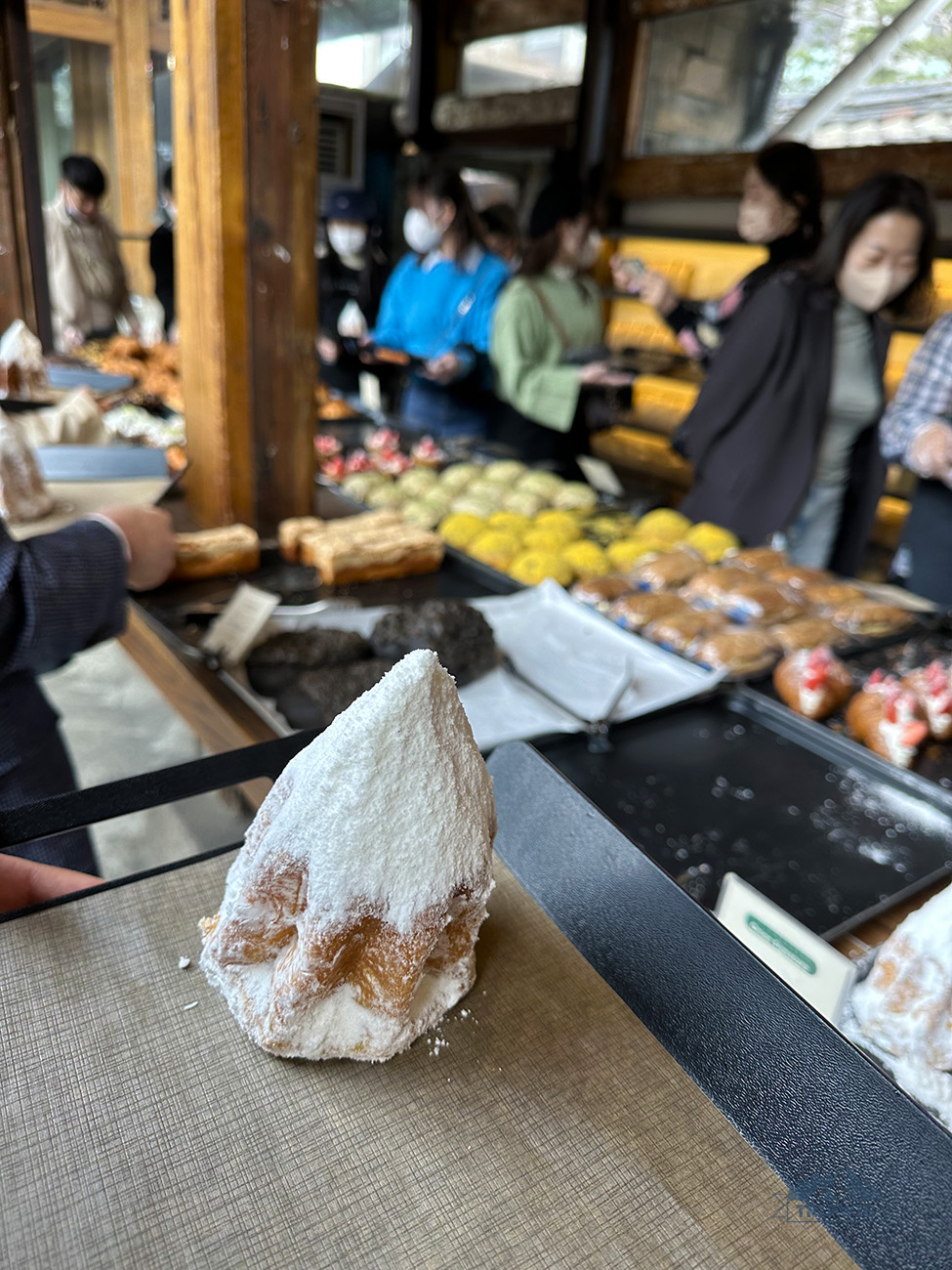 |
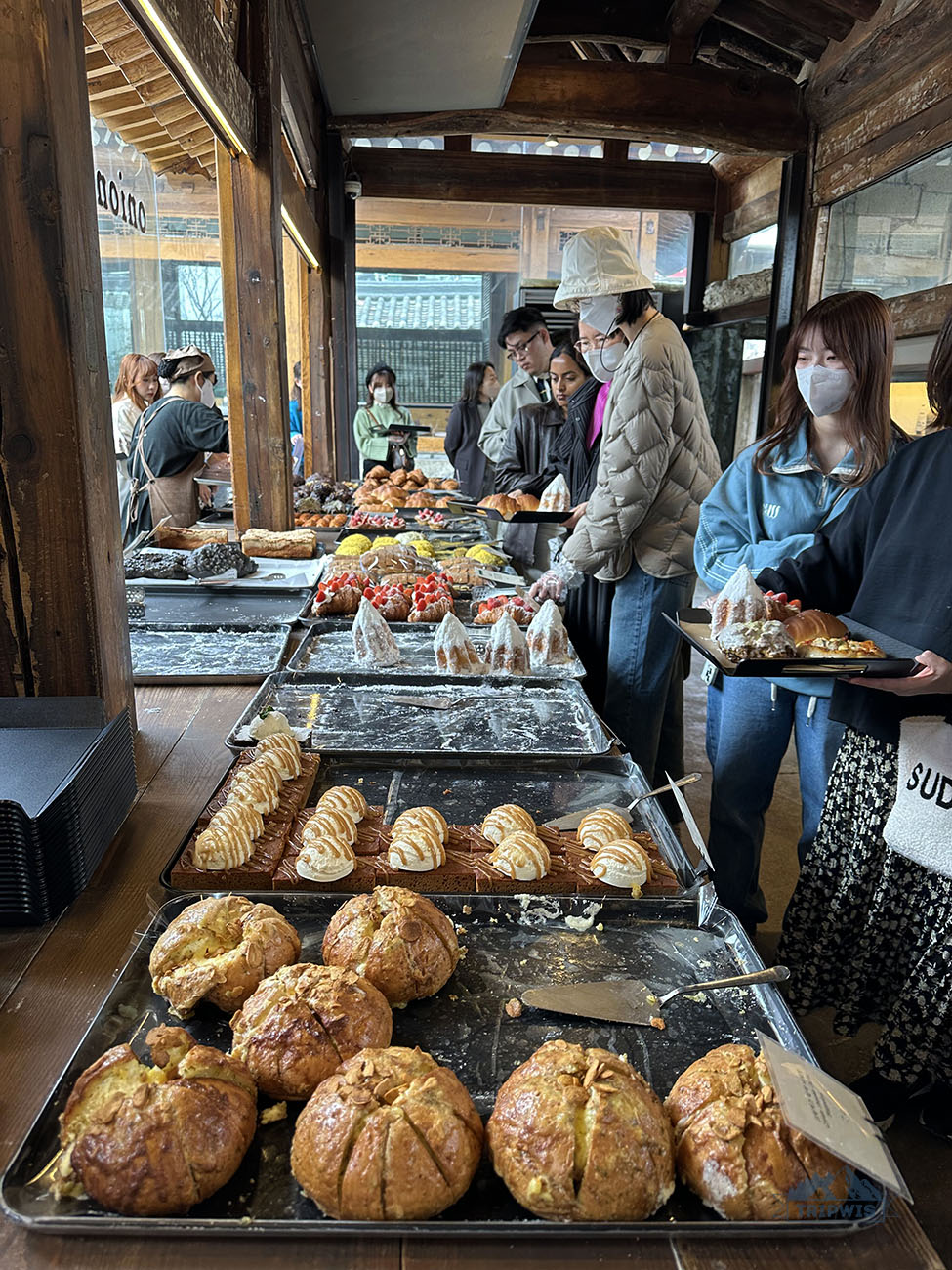 |
Where to eat in Seongsu:
- Vetiver — a tiny, plant filled café famous for its croissant waffle topped with a scoop of vanilla ice cream.
- Café Onion — Seongsu’s cult bakery in a former metal shop: You can expect rustic brick, sunlight through warehouse windows, and legendary pandoro (sweet bread) piled high with powdered sugar.
- Nudake — even the best areas and neighborhoods of Seoul don’t have this one! Seongsu boasts the only Nudake dessert shop in all of the city, famous for pairing experimental desserts that look like modern art with Gentle Monster’s ever shifting interiors.
- AMORE Seongsu — a gallery like beauty store with a sleek in house café.
- Thousand — a minimalist espresso bar featuring single origin pours and airy chiffon cakes, perfect for a quiet breather between showroom hops.
Where to stay in Seoul if your pick is Seongsu:
- 3* H Avenue Hotel Kondae Seongsu (from $80 per night) — hotel with basic yet modern interiors and located within a 5-7 minute walk from everything going on in Seongsu.
- 3* Hotel POCO Seongsu (from $90 a night) — a boutique gem with industrial-chic design that perfectly captures creative spirit, featuring beautiful common spaces and thoughtful amenities just steps from the neighborhood’s best cafés.
Seongsu pros:
+ Trendy neighborhood with aesthetic
+ Authentic local atmosphere away from tourist crowds
+ Creative cafés, art spaces and galleries in converted warehouses
+ More affordable accommodation than central Seoul districts
+ Riverside location with access to Han River parks
Seongsu cons:
— Less convenient for major tourist attractions
— Transportation options more limited than central districts
Gangnam — perfect for shopping
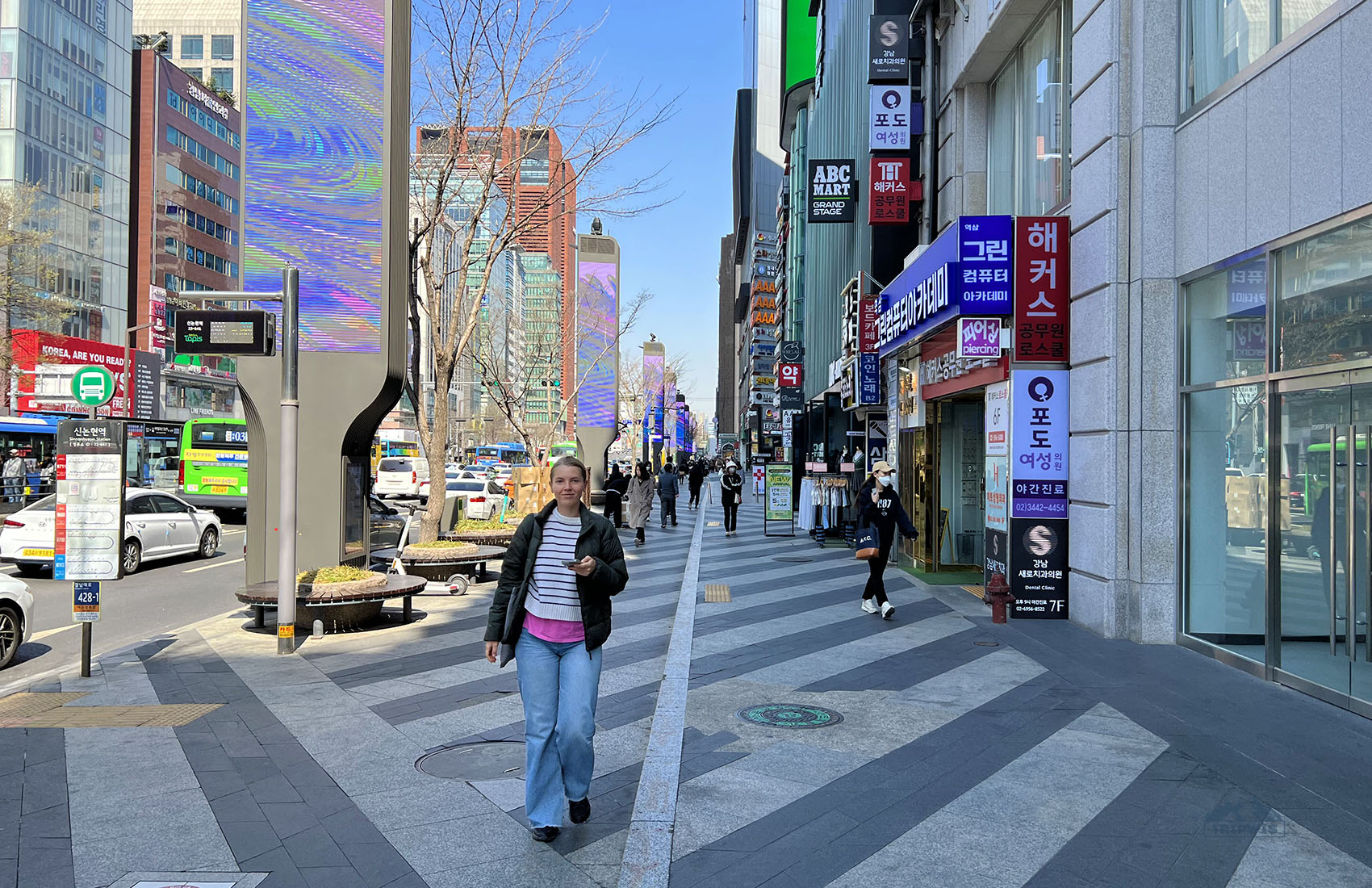
What is the beat area to stay in Seoul? Yes, everyone heard about that Gangnam from the viral hit song but it’s not that simple.
Gangnam sits on the other bank of Han River and it is Seoul’s flashiest, most polished playground where credit cards get serious workouts. Think of it as Seoul’s Rodeo Drive — all gleaming glass, luxury flagships, and restaurants where beautiful people drop serious cash without blinking. This is where Korea flaunts its rags-to-riches transformation with unapologetic swagger.
Be prepared for your wallet to feel the pinch if you stay here — hotels typically demand from $150 per night, a hefty premium over what you’d pay elsewhere in Seoul. While you won’t be stranded (the area is covered by train station hubs on Lines 2 and 9), you’ll spend a good 30 minutes in transit each time you want to see Seoul’s actual historic and cultural sites. Not exactly the best area in Seoul for first-time travelers trying to maximize their vacation time!
Sure, it’s sleek and impressive, but why pay through the nose for a business district when Seoul has so much more character elsewhere? Despite the fancy restaurants and brand-name shopping (which you can find in other areas, too), you’ll miss out on the heart and soul of Korean culture. For travelers hoping to actually experience Seoul beyond shopping malls, spending your precious vacation budget on Gangnam’s inflated hotel prices just doesn’t make sense. Save your won and book somewhere with more charm, better access to attractions, and a genuine slice of Seoul life.
 |
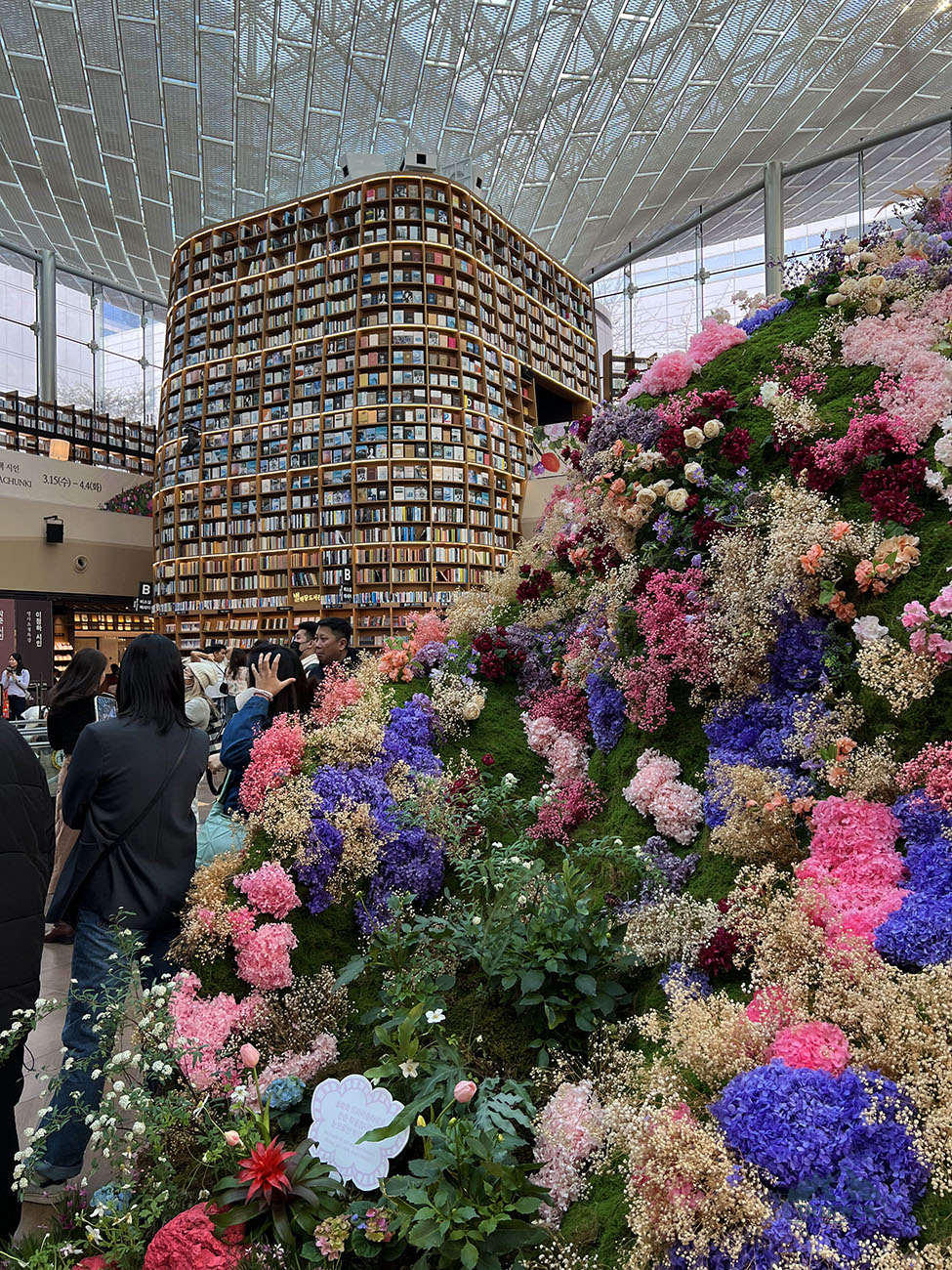 |
Things to do and places to see in Gangnam:
- COEX Mall — a place where you can shop designer brands, stand nose-to-nose with sharks at the aquarium, and immerse yourself in K-pop culture all without seeing daylight.
- Starfield Library — a massive literary oasis right in the heart of COEX Mall, where towering 13-meter bookshelves create one of Seoul’s most popular tourist attractions.
Where to stay in Gangnam:
- 4* Aloft Seoul Gangnam (from $140 a night) — a design-forward spot with a killer lobby bar, tech-equipped rooms, and that signature Aloft vibe that draws the cool crowd. Perfect for night owls who want to dive into Gangnam’s energy then crash somewhere equally stylish.
- 3* Aiden by Best Western Cheongdam (from $100 per night) — a chic boutique hotel with funky design touches, and a prime location that puts you right where Seoul’s fashion crowd hangs.
- 4* Shilla Stay Gangnam Yeoksam (from $130 a night) — sleek Gangnam digs with head-spinning city views, plush rooms, and all the upscale touches you’d expect from the Shilla brand, just steps from the action but quiet enough to crash after a day of Seoul adventures.
Gangnam pros:
+ Excellent shopping with luxury brands, department stores, and underground malls
+ Upscale dining scene
+ Overall modern look, with flashy buildings and buzzing streets
Gangnam cons:
— Higher prices
— Far from tourist attractions
My list of hand-picked Seoul hotels

These hand-picked stays represent the sweet spot where quality meets reasonable pricing in the neighborhoods I’ve explored. Whether you’re planning for solo travel, looking for one night stay, or settling in for a longer adventure, you’ll find something that fits your needs. Just remember to book in advance — especially during cherry blossom season (late March to early April) and autumn foliage (October), when rooms throughout the city fill up quickly!
Side note: You’ll notice that I’m using Trip.com for the hotel recommendations. If you’re not familiar with it, it’s one of the best platforms for finding accommodations in Asia — often cheaper than Booking.com. But it never hurts to compare.
- Drip&Drop (Myeongdong, from $40 per night) — a cozy, capsule hostel where friendly staff and communal spaces create an authentic Seoul experience for budget travelers.
- 2* Namsan Hill Hotel (Myeongdong, from $70 per night) — a decent hotel for a quiet night’s sleep that let us explore hiking routes of Namsan Hill and mayhem of Itaewon district while still being close to Myeongdong.
- 2* The Cube Hotel (from $35 a night) — futuristic pod-style rooms, minimalist design and smart amenities create the perfect crash pad for budget-conscious travelers.
- 3* Moxy Seoul Insadong (Insadong, from $150 a night) — the Moxy chain never lets you down, whether you’re in Europe or in Seoul. It has a fun, youthful vibe, stylish design, creative common spaces, and a rooftop that’s the cherry on top of its already trusted reputation.
- 3* Toyoko Inn Seoul Gangnam (Gangnam, from $70 a night) — budget-friendly but never basic, this reliable hotel provides comfortable rooms in Seoul’s business district, perfect for savvy travelers watching their won.
- 3* Seoul Inn Hotel by The Designers (Gangnam, from $100 a night) — if you want something decently priced yet aesthetic.
- 5* The Shilla Seoul (from $300 a night) — if you thought that “luxury” stands for Gangnam… there is a tiny area just beyond Namsan Hill Park hiding a luxury hotel that doesn’t look like much from the outside, but inside it’s unbelievably beautiful. Every room comes with breathtaking views. It has everything you need, and as a bonus, the subway is just a 5-minute walk away.
What really makes these accommodations stand out is how well-connected they are to Seoul’s subway system. Each place is just a short walk from a station, so you can easily explore all the amazing neighborhoods Seoul has to offer. The super-efficient public transportation means you can venture out to discover the city, then simply hop on the subway to return to your comfortable home base. It’s definitely something to consider when choosing where to stay in Seoul!
My tips for traveling to Seoul
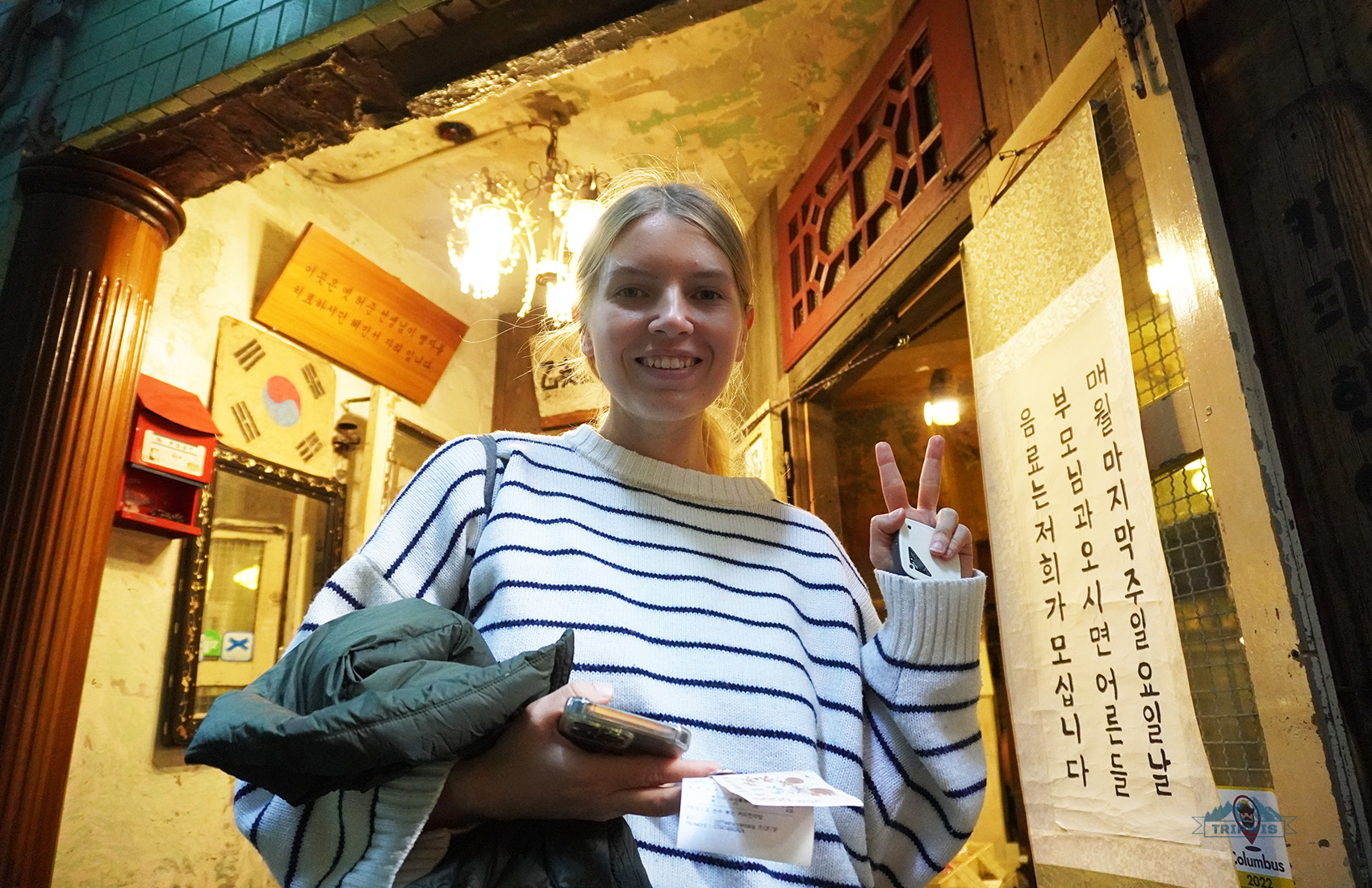
Let’s be real: Seoul is nothing like your average vacation spot. This city throws surprises at you around every corner, and after multiple visits, I’ve collected some tips to help you navigate like a local.
Transportation
The T-money card is your golden ticket. Pick one up at any convenience store or at the airport as soon as you land. This card works on the subway, buses, and even lets you pay for snacks at convenience stores. You’ll save both money and time compared to buying individual tickets. You can find more information about T-money card here.
Forget Google Maps — it doesn’t work in South Korea. Or better say — it doesn’t show the walking routes, only the public transportation options. Download Kakao Maps or Naver Maps before your trip. They will guide you perfectly through the city’s maze of streets.
The subway should be your default. Seoul’s metro system is impressively clean, efficient, and features English announcements at every stop. When the subway won’t cut it, use the KakaoTaxi or Uber app instead of trying to flag down cabs on the street.
Shopping & beauty
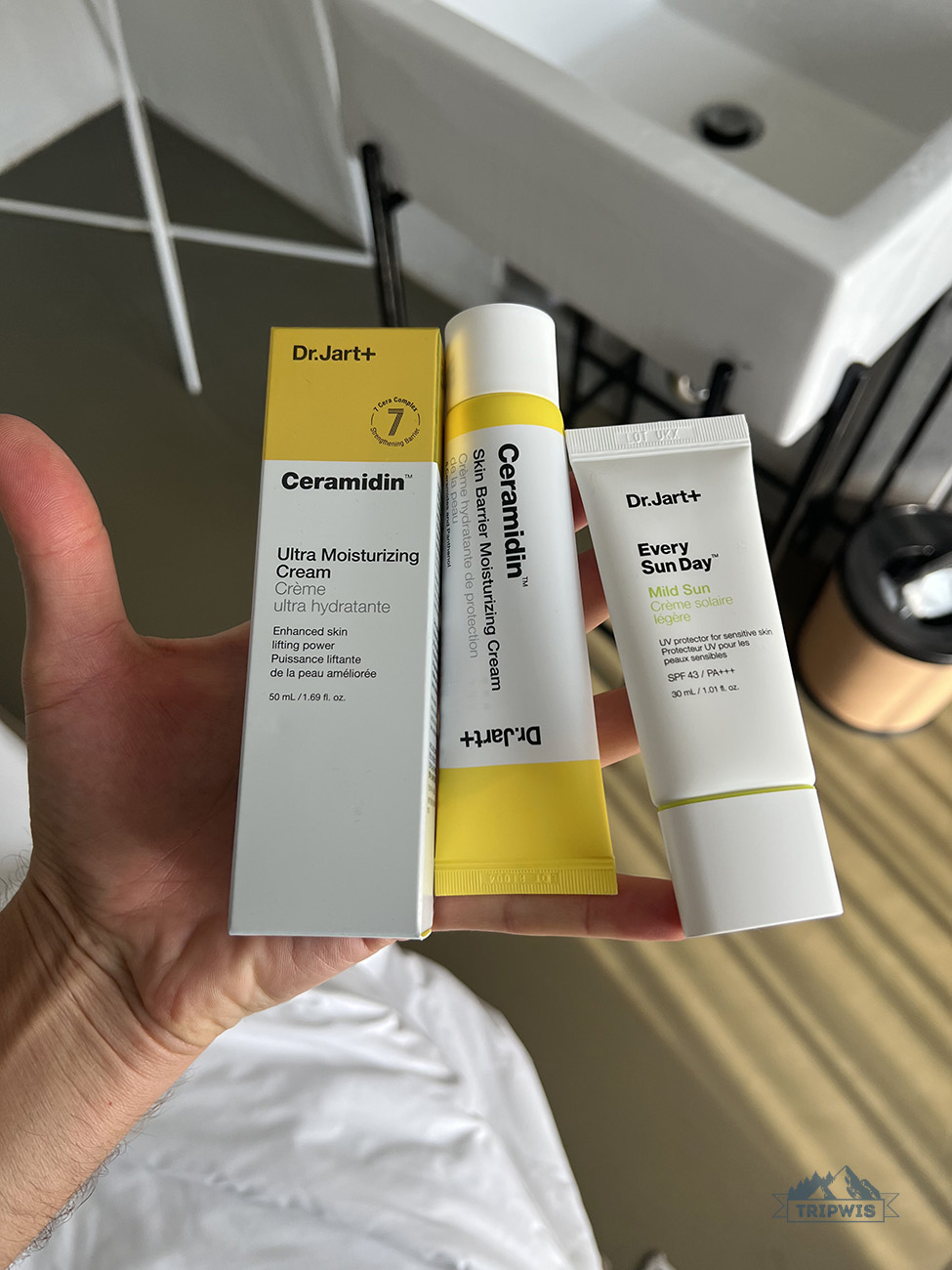 |
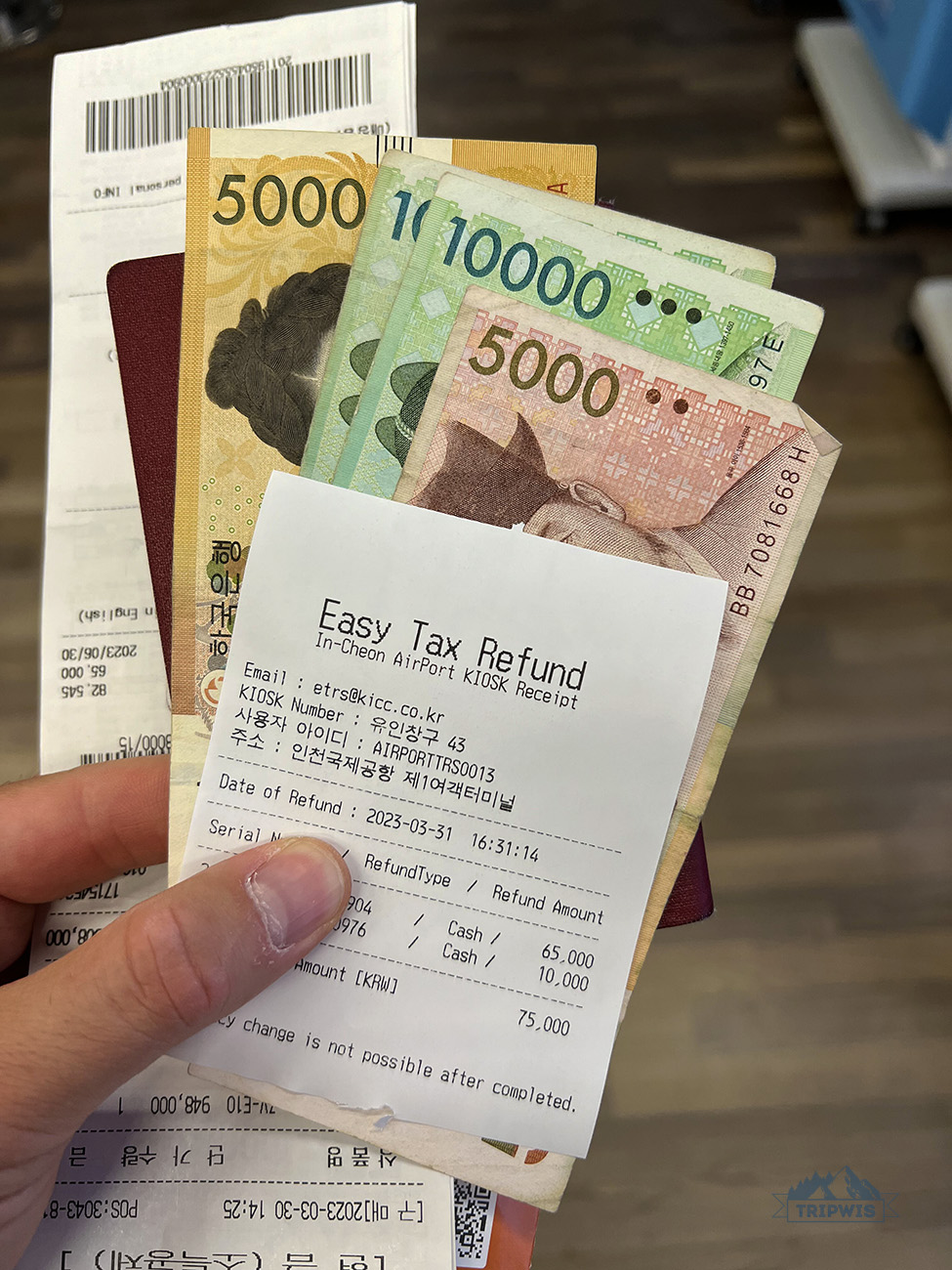 |
Budget separately for retail therapy. Trust me, you’ll want to set aside a dedicated chunk of your travel budget for shopping and beauty splurges in Seoul. Korean skincare and cosmetics are light-years ahead of Western markets, and prices are often better than what you’d pay back home. Want to know how much does it cost to be a tourist in Seoul, eager to try literally everything?
Tax-free shopping in Seoul is a breeze. Look for “Tax Free” signs in stores — many shops offer instant tax-free at checkout when you show your passport, eliminating the hassle of airport refund lines. Bigger department stores might require refund processing at the airport, but the savings (usually 10%) are worth the extra step.
Don’t miss the beauty experiences. Beyond just buying products, budget for actual beauty treatments. From express facials to full Korean spa (jjimjilbang) experiences, these services cost a fraction of Western prices while delivering results that will have your friends asking what you have done differently when you return home.
What is the best area to stay in Seoul?
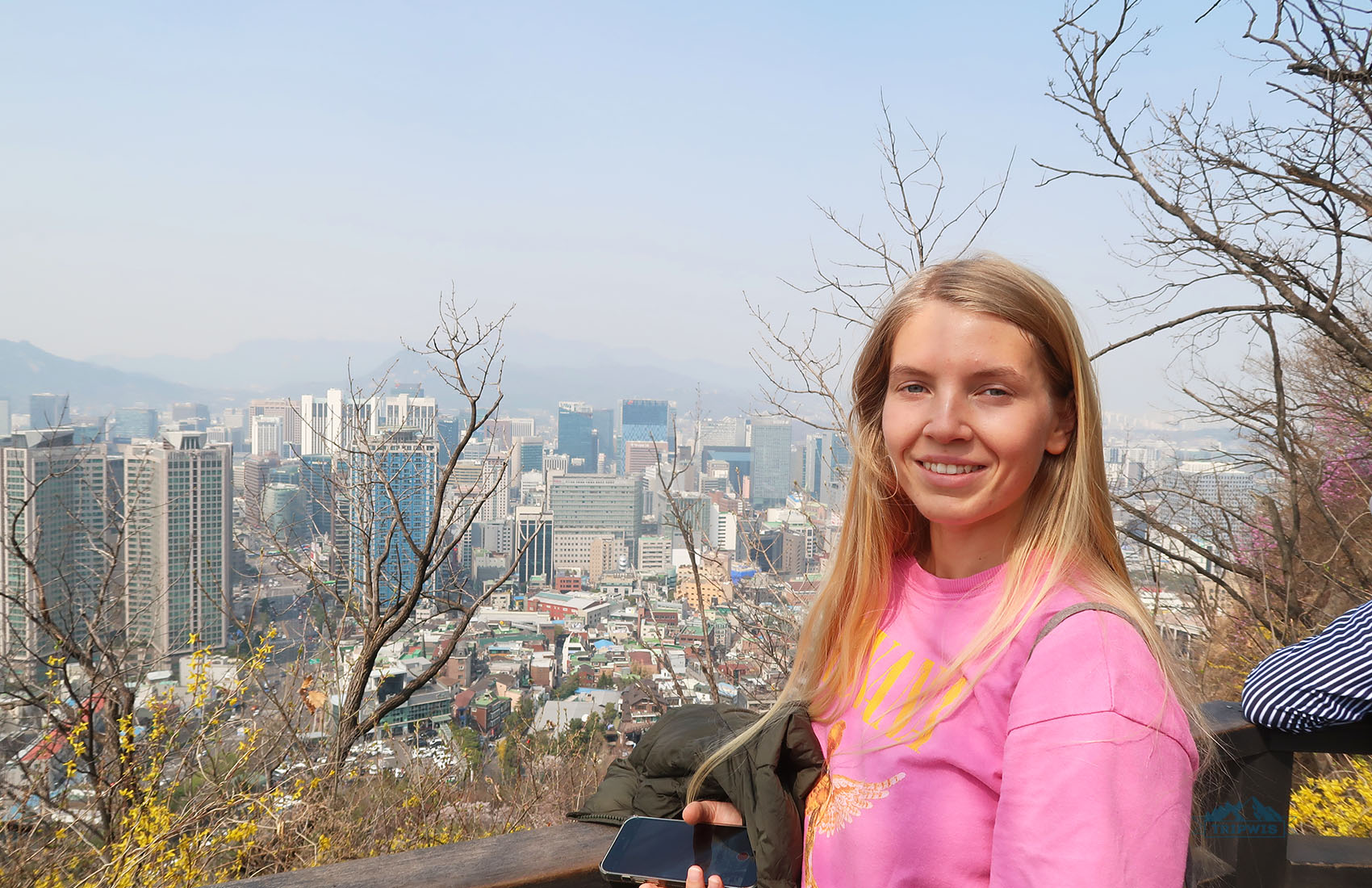
After exploring Seoul’s diverse neighborhoods, you might still be wondering: “So, where should I actually stay?”. The answer depends on your priorities, but here’s my breakdown to help you decide:
- First-time visitor:
If you’re visiting Seoul for the first time — Myeongdong remains my top recommendation for first-time visitors. Its central location puts you within walking distance of palaces, shopping, and countless restaurants, while its extensive subway connections make exploring the entire city effortless. Yes, it’s touristy and bustling, but that energy is part of what makes Seoul so exciting.
- Budget options (under $60/night):
For travelers watching their wallet, Bukchang-dong offers the best value without sacrificing location. You’ll find clean, comfortable guesthouses and budget hotels just a short walk from major attractions. Another solid choice is the outer edges of Hongdae, where university-dense area means reasonable rates while keeping you close to great food and nightlife.
- Mid-range options ($60-$150/night):
Those with a moderate budget should consider Insadong for its perfect balance of traditional charm and modern convenience. The traditional hanok guesthouses here offer a unique cultural experience without breaking the bank.
- Luxury stays ($150+/night):
If you’re splurging, the high-end hotels in Gangnam deliver world-class service and amenities. For a more unique luxury experience, the boutique hotels nestled in Bukchon Hanok Village offer traditional architecture with modern touches and incredible city views.
If I had to pick just one neighborhood for a one-week stay that balances convenience, atmosphere, and value, I’d choose Insadong. It’s central enough for easy exploration but quieter than Myeongdong, rich in cultural experiences, and offers accommodations for every budget level. Plus, its central location means you can easily visit other districts for shopping, nightlife, or whatever else catches your interest during your Seoul adventure.
Remember that Seoul’s excellent public transportation system makes it easy to explore the entire city regardless of where you stay. The perfect neighborhood for you ultimately depends on your personal travel style, but I hope this guide helps you find your ideal Seoul home base!
